RAAC discovery forces students out of UEA accommodation
Molly Warner News Editor
The University of East Anglia sent out an all-student email from Ian Callaghan, Chief Resource O cer and University Secretary, on the 8th of September 2023, declaring that “In response to new government guidance on RAAC (Reinforced Autoclaved Aerated Concrete), some UEA student accommodation will be closed as a precautionary measure, whilst further investigations are carried out”.
He explained that “Norfolk and Su olk Terrace (the Ziggurats) will be closed, as well as the top floors of Nelson Court and Constable Terrace. We do not believe that any other UEA residential or nonresidential buildings are a ected.
“Visitor accommodation in Broadview Lodge is also being closed for further investigations.”
All a ected students have been allocated alternative accommodation. Just under 600 students have been provided with rooms elsewhere on campus, while the remaining 170 will live in St Crispin’s House on Duke Street, Norwich. Students in St Crispin’s will be o ered a free bus pass or a voucher to purchase a bicycle. All the rooms are either of equivalent or be er quality than the original accommodation and have been provided at no extra cost.
Students with accessibility and mobility issues have been prioritised to stay on-campus and flat share groups have been kept together where possible.
RAAC is a lightweight form of precast concrete, frequently used












within public sector buildings in the UK from the mid-1960s to the 1990s. UK governments have been aware of some of the vulnerabilities of RAAC since the 1990s. A safety alert was published in May 2019 by the Standing Commi ee on Structural Safety (SCOSS) following the sudden failure of a flat roof in a school that was made from RAAC.















The Prime Minister, Rishi Sunak, announced the dangers of buildings that had been constructed utilising RAAC just before the summer holidays were due to finish, and ordered that school buildings built with this form of concrete should be shut and replaced immediately.
He said that the example that has










now been set by schools would not necessarily have to be followed by other types of public building, including prisons and hospitals. “Departments individually will follow that advice as it relates to their particular estate,” he said. “It is very specific to the circumstances of individual buildings and how in particular they can be monitored and assessed. For example, the NHS has been looking at this for years, and has a mitigation programme in place which is funded with £700m already.”
In conversation with Concrete about UEA’s situation, the Vice Chancellor, Professor David Maguire, answered questions on how the process of relocating students will work, and what we can expect from the coming months:





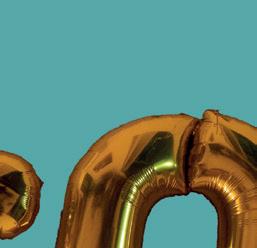

“We’ve done a preliminary survey of the buildings on campus and we believe that there is RAAC in three of the buildings; the Ziggurats, Nelson Court, and Constable Terrace. So, as a precautionary measure, we’ve closed all of those to students and sta , pending further detailed investigation.
“I suspect, because of the construction method of the Ziggurats, that’s likely to be a longterm challenge for us to resolve.





“Obviously, the safety of students and sta is completely paramount and will override all of the considerations in this, and we will not be doing anything that will increase the risk for anybody.
“We have agreed that (the relocation of students) will not materially a ect students financially in terms of their ability to be successful academically. So, when they’re rehoused we will honour the agreed prices that they were due to pay.
“I hope that it all works out and that students will forgive the unfortunate circumstances, but we’re going to do our very best to take care of them.
When asked if Professor Maguire was confident that there is no other RAAC present within the teaching buildings, he answered “Yes, thankfully”.
Continue reading article on page 3 ...







The o cial student newspaper of the University of East Anglia | Established 1992 | Issue 395 | 19th September 2023
pg. 18 Interview with UEA's ViceChancellor pg. 12-13 UEA's 60th Anniversary Venue: pg. 8-9 What we know so far about OurFlag Means Death
Photo: Concrete- Samuel Baxter
Photo: Samuel Baxter
New Year, Old Me
Ma hew Stothard Co-Editor-in-Chief
Hello again! Well this is weird isn’t it! If you’re new here, I’m Ma hew, one of this year’s Editors-in-Chief, and if you’re not I’m the one who’s been regaling you all with my life story in these editorials for the last year. Hope you don’t mind me writing a few more!
Bittersweet Beginnings
Eve A wood Co-Editor-in-Chief
I could lie and say I’m feeling rejuvenated to begin this semester, but the reality is I’m feeling a whole host of emotions. A new term o ers the opportunity to press the restart bu on, start fresh and enter a whole new chapter, but this year is also bi ersweet for me. I’m starting my final year at UEA as an undergraduate, and the thought of leaving and moving on is both scary and exciting.
On one hand, there’s the prospect of new and exciting opportunities such as starting a career in a sector you’ve always been interested in. But on the other hand, there’s the thought of saying goodbye to UEA, to Norwich as a whole, and to all the friends I’ve made here. The thought that after this year we will all be sca ered across the country, not just down the road from one another or a bus ride away is strange to think about.
One thing I want to remind myself and other students to do is to stop worrying so much about tomorrow, or next month, or the next year. The time we have at university is so finite, so it’s important to enjoy the present for what it is, and to take every opportunity you get.
I’m sure this year will be filled with many ups and downs (particularly around summative season!), but that’s all part of the university experience. While I know my time at university will inevitably be coming to an end, I am going to cherish every moment instead of wishing time away.
I am so excited to be co-editing this year with Ma hew, and this team has already made me so proud with the first issue. Across Concrete, we have a whole
host of articles this issue on UEA’s 60th anniversary, as well as great content for freshers and returners looking for events and activities to go to. We also had the opportunity to interview UEA’s Vice-Chancellor, David Maguire, talking to him about the university’s financial situation, as well as the future of Arts and Humanities.
For those wanting to get more involved in Concrete, we have our annual Big Meet taking place on the 28th September at 6.30pm in Lecture Theatre 4 where you can find more information on how to get involved with writing articles or joining the team.
We will also be advertising the roles of Anne Glia (Agony Aunt) Writer, HOTW Senior Writer, Online Editor and Social Media Manager on our Instagram, so keep an eye out for updates on those if you’re interested.
Whether you’re a fresher or a returner, I hope you have a great start to the year. It may be stressful at first – adjusting back often is, but after a while, things will fall into place.
Have a good time at Welcome Week and stay safe on your nights out!
Whether your nights are spent at the LCR, sat by the lake, or in the library, you’re sure to make plenty of amazing memories this year.
Since my last editorial I’ve been to Eurovision (one of the best experiences of my life!), graduated from my History degree, edited A Week in Concrete into a podcast (you can search for it on Spotify!), been to the National Portrait Gallery (which is amazing by the way – would recommend!) and lots of museums (and their gift shops of course!). Hopefully that list gives you a pre y good sense of who I am!
Most relevant to you though, Eve and I have been working insanely hard to get this issue of Concrete into your hands, and if you’re reading this then we’ve been successful! It’s not just us though, we’re very proud of our amazing team who have done a brilliant job in a challenging first layup week!
I’m going into an MA in Early Modern History and I hope you’ll see the historian’s touch across our issues this year, and certainly in this one. Firstly, this time we are celebrating UEA’s 60th anniversary, with excellent articles looking at the university’s impressive alumni throughout Concrete and Venue, as well as my brief history of UEA (which I had a lot of fun pu ing together) on page 8.
I’m also very excited that we’re launching a new regular feature in
HOTW delving into the Concrete archive! I first wrote about its value for the 30th anniversary issue in February 2022, and after having a great time digging through all the old issues over the summer, I’m thrilled to be able to bring you some hidden gems from the last 32 years!
We’ve made some other changes too, with Features now focusing more on investigative journalism and student interest topics, while Lifestyle has been given a new lease of life exploring student experiences (now including Anne Glia!). You can also find a brand-new Puzzles section on page 21, an idea brought to us by our Puzzles Editor Cal and one I’m sure my Dad in particular will love!
At its heart though, this is still the same Concrete I joined as a Fresher three years ago. My mission statement for the paper has been and remains this: we will always produce our content with balance, compassion and integrity, holding power to account whilst caring for and supporting our Concrete and UEA communities. We will also continue to champion the arts and humanities across both Venue and Concrete, whilst celebrating everything that makes UEA so wonderful across all disciplines!
Concrete has shaped my university experience so far. It has given me amazing opportunities and introduced me to so many wonderful people. Whether you come and join us as a writer, or just give us a read, I hope we can bring you some of the same joy it’s given me.
Solutions for crossword on page 21

The University of East Anglia’s O cial Student Newspaper since 1992
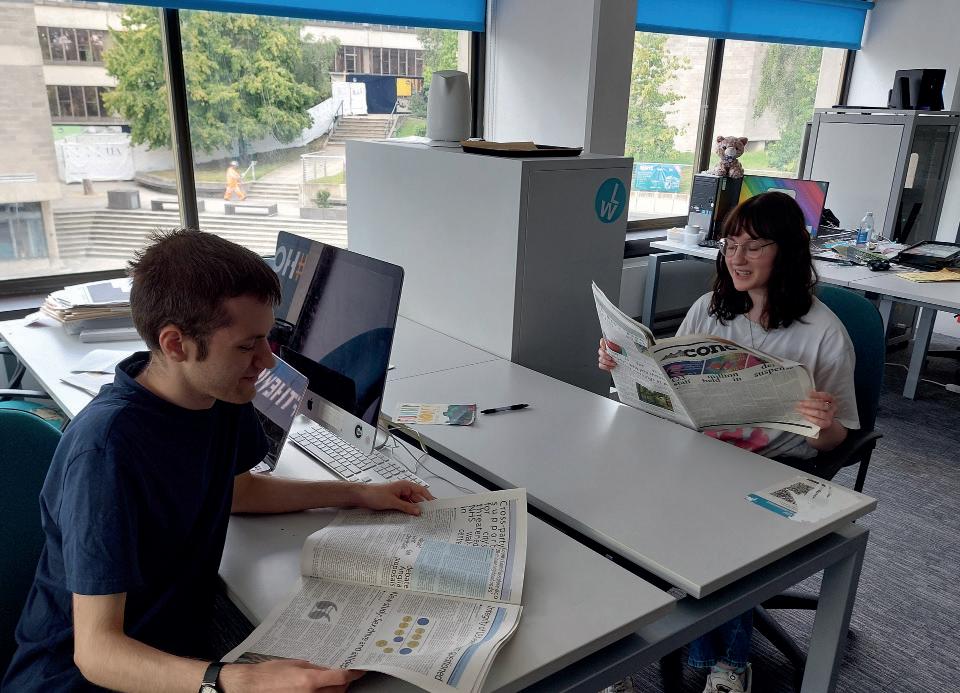
Tuesday 19th September 2023
Issue 395
Union House
University of East Anglia
Norwich NR4 7TJ
www.concrete-online.co.uk
Editor-in-Chief
Eve Attwood
Matthew Stothard concrete.editor@uea.ac.uk
News
Molly Warner
Senior Writer: Jamie Bryson
Home of the Wonderful Fiona Hill
Global
Syed Hamza
Senior Writer: Sankavi Naresh
Features
Eleanor Radford
Comment
Sam Slade
Science
Rana Darwood
Senior Writer: Max Todd
Travel
Cordelia Gulbekian-Faram
Puzzles
Cal Paul-Moola
Lifestyle
Mia Galanti
Sport
So a Royal
Senior Writer: Felix Sumner
Online Editors
Dan Laughlan
Cavin Balakrishnan Ramesh Kumar
Concrete Photographer
Innes Henry
Venue Team
Millie Smith-Clare
Tsquesha Williams
Lily Glenn
Sara Budzinska
Sophie Handyside
Caitlin Bennett
William Muncer
Lily Taylor
Ore Adeyoola
Lucy Potter
Cut-outs: Unsplash, UEA, Unsplash
Editorial Enquiries, Complaints & Corrections concrete.editor@uea.ac.uk
No part of this newspaper may be reproduced by any means without the permission of the Co-Editors-in-Chief, Matthew Stothard and Eve Attwood. Published by the Union of UEA Students on behalf of Concrete. Concrete is a UUEAS society, but retains editorial independence as regards to any content. Opinions expressed herein are those of individual writers, not of Concrete or its editorial team.
19th September 2023
EDITORIAL 2
Photo: Concrete/ Molly Warner
SU Officer comments on RAAC disruption
 Molly Warner News Editor
Molly Warner News Editor
Continued from front page...
Luke Johnson, Activities and Opportunities Officer for UEASU, released a statement on behalf of the Student Union Officers, saying that “The Students’ Union found out about RAAC concrete being in our campus accommodation on Friday 8th September.
"Following this, we wrote a letter to the university asking for more information and raising our concerns about the impact on students.
“Our main concern is the impact it could have on students’ mental health and wellbeing.
"First year students are, ultimately, vulnerable. They could be travelling from 4 hours
away or catching a flight from the other side of the world.
"Alongside the cost-of-living crisis, this is another stress being placed onto students and we will ensure that the university puts students first.
“Most importantly, I want to stress to those affected that campus, and our union, remains open.
"We will still run events and put students at the forefront of everything we do.
“If students are placed off campus and find themselves directly impacted by this issue, please contact our advice team - ueasu.org/advice or the universities wellbeing team.”
'Cancel culture' a non-issue for English universities
Jamie Bryson
Senior News Writer
Almost 9 in 10 students feel free to express their opinions and beliefs, according to the Office for Student’s National Student Survey, which the government officially backs.
Such evidence contradicts recent claims by various politicians and commentators, including former Culture and Media Secretary Nadine Dorries.
86% of the 300,000 surveyed said they were ‘free’ or ‘very free’ to express their “ideas, opinions, and beliefs” during their time at university; just 3% said they were “not free at all” to express their views.

At the University of Oxford, Buckinghamshire, New University, the University of West London, and Imperial College London, a record 90% (or more) of students responded they felt ‘free’ to express themselves.
In May, the government enacted the Higher Education (Freedom of Speech) Act, which requires universities and student unions to “secure freedom of speech within the law for staff, students and visiting speakers”.
In addition, the act established a “free speech tsar” within the OfS, appointing Prof Arif Ahmed of the University of Cambridge as the new director for freedom of speech and academic freedom.
Nick Hillman, director of the Higher Education Policy Institute, commented: “Some of the questions in this year’s survey were added to embarrass universities and bolster the government’s case.
"But, this result on free speech is in line with earlier surveys and suggests that threats to free speech are less of an issue among students.
Higher Education Minister Robert Halfon responded, “Our universities are world-
leading and rightly preserved as institutions encouraging free speech and debate.
"I’m particularly pleased that 86% of students in this year’s survey felt able to express their ideas, opinions and beliefs freely.”
Whilst there have been some examples of ‘de-platforming’ and event boycotts over the past five years - including of former Home Secretary Amber Rudd at The University of Oxford in 2021 - multiple surveys suggest such incidents are largely isolated and do not have a significant impact on student opinion.
A third-year undergraduate (who asked to remain anonymous) expressed to Concrete, “I think it’s really interesting that despite the government’s efforts to try to create this sort of culture war and weaponise the experiences of a few disgruntled students, the evidence shows that universities are still places for young people to express their opinions, learn, and grow”.
Furthermore, third-year undergraduate Joseph Stretton commented, “The findings are reassuring and unsurprising.
"The accusation of 'cancel culture' being a 'blight' on universities is a good example of how terms used on the internet are often woven into the political rhetoric of MPs in an attempt to seem up to date with trends and terminology”.
Another student (who wished to remain anonymous) added, “It’s certainly possible that the Conservative government
has disproportionately trumped up this issue, but cancel culture is a real thing, and there’s no good reason why any non-extremist person should have to fear expressing their opinions.
"Free speech isn’t perfect, but with the appropriate checks and balances, it gives an open space for informative discussion that, in the end, doesn’t leave people feeling scared to speak up. And I say this as a socially liberal person”.
Finally, a student (who also asked to remain anonymous) told Concrete, “I feel students are free to express themselves in places such as university when it comes to progressive views and fashion.
"However, I feel if your views are slightly different to extreme liberalism (for example, if you’re religious or don’t fully understand certain elements of the LGBTQ community), you’re encouraged to stay quiet instead of asking questions to gain insight and a better understanding, which can
3 NEWS concrete-online.co.uk/news/ | @ConcreteUEA
What do UEA students think?
“Almost 9 in 10 students feel free to express their opinions and beliefs”
Image: Concrete/Matthew Stothard
End of marking & assessment boycott
Molly Warner News Editor
On the 20th April 2023, the University and College Union (UCU) called for all members from Universities that are part of the pay and working conditions dispute to “cease to undertake all summative marking and associated assessment activities/duties. The boyco will also cover assessment-related work such as exam invigilation and the processing of marks.”
UEA ‘cautiously optimistic’ it will avoid compulsory redundancies
Ma hew Stothard Co-Editor in Chief
Following further voluntary redundancies, as well as the removal of vacant posts and redeployment opportunities, the University of East Anglia’s leadership are ‘cautiously optimistic’ that the required savings of £30m will be made this year without compulsory redundancies.
The university had previously said it was “unlikely all savings can be made without compulsory redundancies,”, and 113 jobs were put at risk over the summer across Professional Services and academic staff, however on 18th August UEA Council approved a recommendation not to convene a redundancy panel.

Deputy Vice-Chancellor Professor Christine Bovis-Cnossen said this “is what we always hoped to achieve. This decision will remain under review while we continue to work through the processes in those few areas with staff still at risk. It is dependent on our voluntary redundancy, redeployment and voluntary contract reduction processes reaching a successful conclusion to meet our required savings, and many of those are still progressing. We anticipate being able to have a full assessment of the impact of these cost savings in the autumn.”
This comes as UEA sees an 11% increase in new student numbers from last year, with over 7000 new starters arriving this month. This will come as further good news to the university who had previously
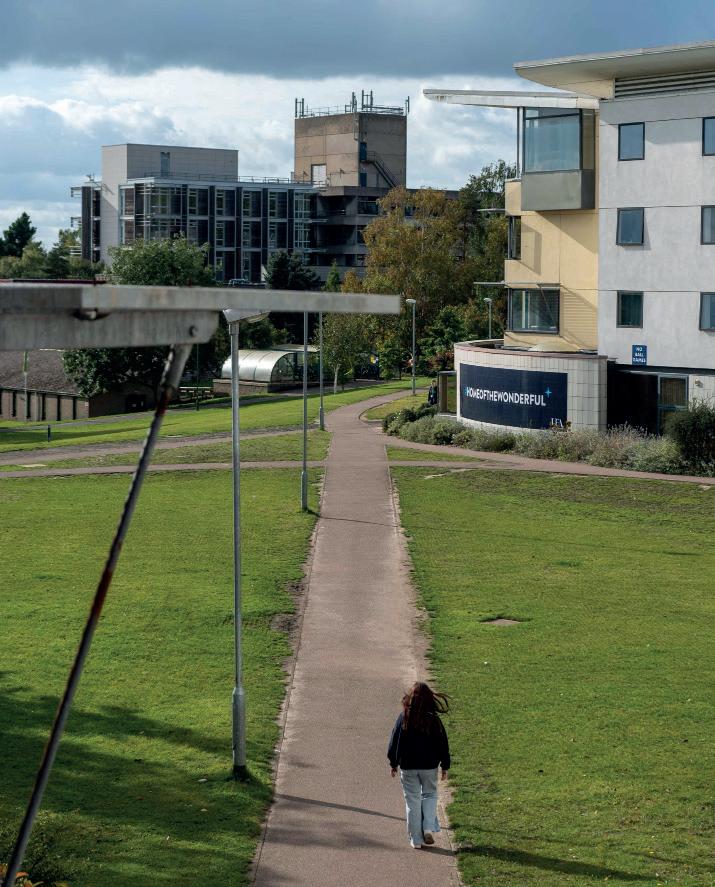
cited falling student numbers as one of the contributing factors in its financial difficulties.
It is important to note that everyone who graduated from the University of East Anglia this year, graduated with a classification.
In recent weeks, the UCU have released a statement saying that “Following a consultation with the membership, the marking assessment boyco has been withdrawn, on Wednesday the 6th of September 2023.”

However, despite the withdrawal of the marking and assessment boyco , UCU have released a second statement, informing its members of the future strikes that will take place in response to the pay and working conditions dispute: “The Universities and Colleges Employers Association (UCEA) naively believed that not se ling during the MAB would mean the end of the dispute. They couldn't be more wrong. They couldn't have underestimated you and your union more. The HEC has called five days of strike action later this month from Monday 25 to Friday 29 September”.
casualisation and unacceptable pay inequalities. Our strike action and ballot are a ramping up of this dispute to deliver a victory as soon as possible. We remain ready to talk. Ready to fight. Ready to vote YES.", says Jo Grady, UCU's General Secretary.

Information on the upcoming strikes that will take place between these dates can be found on the UCU website, which includes the list of partaking Universities, although UEA is not included at the time of going to print.
help our financial position.”
Speaking to Concrete, the ViceChancellor Professor David Maguire welcomed the increase as it would make campus “an exciting place to be,” and “considerably help our financial position.”
"I want to be clear--this fight is not over. We will not give up until we have delivered the deal that addresses years of pay cuts, unbearable workloads, rampant
UK Universities offer three-day week to help students balance part-time work
Libby Hargreaves News Writer
Prof Bovis-Cnossen added that, “We have worked hard to resolve our financial issues and following a successful student recruitment round in 2023/24, we are moving forward with confidence and optimism for the future. We look forward to welcoming many new and returning students to Norwich.”
It was announced at the end of August that some UK universities will offer a three-day week, switching to a more “compact teaching timetable” in order to allow students to find work or more efficiently balance their existing part-time work commitments.
The announcement comes as students across the country battle the cost of living, with the average weekly shop last month coming in at £73.20 according to Which?. Additionally, UEA’s current cheapest on-campus accommodation (a twin Ziggurat room) totals at £361.20 per month whilst the most expensive room checks out at £776.16 per month (a Hickling and Barton en-suite room).
These rising basic costs are no longer covered by many students’ maintenance loans, which aren’t increasing to meet inflation. On this economic backdrop, it is no surprise that more and more students need to work to support themselves at university. Last academic year, 55% of students worked alongside their studies according to the Higher Education
Policy Institute, this figure is a 10% increase on the year before. The Guardian recently called parttime work for students “practically essential”, a sentiment which is reflected in the average hours per week students work; a figure that has increased from 4.8 in 2019 to 7.5 in 2023, with many students working near full-time hours. But what does a threeday work week mean?
De Montfort University trialed these “compact timetables” last year for half of its courses and is now introducing them across the entire university in September.
In the compact teaching model, lectures and seminars are ‘compacted’ to two or three days, as opposed to throughout the week- in De Montfort’s model students study one module for seven weeks, as opposed to four at a time- meaning they can focus solely on a topic and on paying the bills, hopefully resulting in better grades and better mental health. Their Vice-Chancellor Prof. Katie Normington explained the move made “organisation easier” for students and that “internal surveys show [the students on the trial] were about 10% happier than those” studying the traditional way. Other universities
which are also implementing this model include Coventry, Sunderland and Anglia Ruskin. The VC also explained they had seen a rise in commuter students as a result of the change as they find it cheaper and easier to take public transport only a couple of times per week, instead of for an hour or so every day.
We spoke to some UEA students who have juggled study and work throughout their degree about whether they would like to see the same changes implemented here. One AMA student described how “beneficial” this would be for her; “I study humanities and only have limited contact hours…I am in for max 10 hours a week spread over five says which makes part-time job workarounds difficult. I’d be able to save money on the bus and have days where I can stay home and dedicate my day to completing my readings and tasks for the week”. Career Central, the student worker system and the SU all contribute to make it easier for UEA students to fund their studies under the current teaching model but it may be time to utilise these services in tandem with this three day working week to create more reliable, longterm roles for those struggling.
NEWS 19th September 2023
4
Photo: Wikimedia Commons Photo: Concrete/Samuel Baxter
“We are moving forward with confidence and optimism for the future”
Photo: Concrete/Jamie
Photo: Concrete/Prakrita Rahman
Photo: Concrete/Samuel Baxter
Cost of Living Crisis - An Update for Students
Ma Newson News Writer
According to data from the National Union of Students, and the Unipol housing charity, the combined cost of tuition for the average undergraduate student within England is estimated to now be £49,887, with tuition costs averaging out at £9,250 each year.
With rising costs of housing, food prices and energy bills, university students are facing di cult times in a ording the cost of studying away from home at university.
The cost of renting has risen sharply within many cities across the UK this past year, as competition for properties has surged dramatically. In addition, the cost of university accommodation has increased signi cantly too. The average monthly cost of accommodation at the University of East Anglia is now £755 each month, in total about £7,550 for the 10-month tenancy.
In addition, the cost of food has also risen within the past 12 months. Some wholesale prices have fallen in recent months, and supermarket chains such as Tesco and Sainsbury’s have been accused
of keeping prices higher than they need to be, directly hitting the pockets of their customers. Regulators have now instructed these supermarket chains to make pricing clearer.
The O ce for National Statistics has said that many students have had to miss out on meals, or leave the heating o throughout last Winter, in order to reduce
weekly shop in Aldi, and after that, will I have enough to cover my rent and soaring energy bills the following week?”
In an attempt to tackle energy prices, the government launched the ‘Energy Price guarantee’ in October last year, which aimed to limit a typical household’s annual energy bill to £2,500 last winter. The scheme, for England, Scotland and Wales, is still in place, although hasn’t been required since July, as a result of the fall in a typical energy bill, which has now averaged to be around £2,074 a year, under Ofgem’s energy price cap. It is understood that this will fall even further in October.



their amount of spending. Many students have worked extra hours, sometimes in various jobs, in an attempt to make ends meet.
“It can’t go on anymore” an anonymous UEA Student says.
“This is meant to be the time where I can trial new things, go out and see new places, and just enjoy my time at university, but I spend every minute worrying about how much I’m going to spend at my
Students from all across the UK now claim that they have had a much poorer experience of university as a result of the cost-of-living crisis. This issue is a ecting areas of health, wellbeing and even academic performance.
These ndings come from the results of another survey by ‘Save the Student’, which also shows how the respondents (University Students) spent an average of £1,078 per month
on living costs, an increase from £924, only a year earlier. Every category of spending had increased, such as energy bills, water bills, food and transport, but the biggest increase was a £21 surge in rent each month.
Further research suggests that 55% of students are now doing paid work, compared with a total of 45% only a year ago. In the survey, which contained over 10,000 student respondents, 76% agreed that the cost-of-living was having a negative impact on their studies.

“I can’t focus. I am constantly
UEA's Pharmacy Closure causes issues for members of the local community
Molly Warner News Editor
At the end of July 2023, Boots’ pharmacy confirmed the closure of the University of East Anglia’s branch, based next door to the Medical Centre just off of Bluebell Road.
The closure comes as a result of Boots’ bid to consolidate shops that are within close proximity to one another. Boots will be shutting a total of 300 shops in the UK that are within a few miles of other branches, but has said that the closures will not lead to any redundancies.
The closure at the University of East Anglia will leave around 17,000 students needing to travel to Eaton, Dereham Road or Longwater to receive minor medical assistance.
A spokesperson for Boots said that “We can confirm that the store is part of the Boots store consolidation programme previously announced. All team
members from these stores will be offered alternative roles”.
Local Norwich South MP, Clive Lewis, has been active in working towards the reopening of the pharmacy, but at this moment in time, there are no plans for the pharmacy to return to the University campus.
“Many concerned local residents and students have contacted me about this,” said Mr Lewis. “Alternative pharmacies will be challenging to get to for many people, especially those without cars. Working with local communities, I will continue to do whatever I can to stem the relentless creation of 'pharmacy deserts' across our city."

Towards the end of August, Mr Lewis met with the Students’ Union Officersincluding the Welfare Officer Nathan Wyatt - to jointly campaign for the reopening of the Boots’ pharmacy.
In an exclusive conversation with Concrete, Nathan
exclaimed that “The Boots closure is going to be a real pain for so many people this yearstudents, staff, and members of the local community are all going to lose out.
“By closing before the end of their contract in October, Boots has chosen to leave UEA without, what is for many, an essential service.

“They should apologise to both UEA and the local community for this decision based solely on the profitability of this one store.”
On social media, Nathan has been vocal in raising awareness of this issue, adding to his statement that, “With the allday bus pass now costing £4.50, students will have to pay even more to access the medicine that they need. We’re working hard and have been speaking to both the university and local community leaders to find solutions”.
As well as this, a student at UEA, who asked to remain
anonymous, has said that “With the cost-of-living crisis affecting myself and other students, the added expense of travelling to pharmacies only increases the difficulty of avoiding unnecessary spending. I used to be able to ensure I could pick up my prescription on my way back from finishing my lectures for the day, but now must travel towards Eaton, the opposite direction to my house, just to receive what is a necessity to me.”
The Boots pharmacy at UEA currently has no plans to reopen, however, below is a list of some of the closest pharmacies to UEA, as well as their opening hours. Each are within walking distance, or are on the 25/26 bus route that you can access from the University’s main bus stop. Please note that all of the listed pharmacies are wheelchair accessible too.
Boots, Dereham Road, NR5 8TU8:45AM-6:00PM
concrete-online.co.uk/news/ | @ConcreteUEA 19th September 2023 5
“University students are facing di cult times in a ording the cost of studying away at University"
“76% of students agreed that the costof-living crisis was having a negative impact on their studies”
“The closure will leave around 17,000 students needing to travel to receive medical assistance”
Concrete/Prakrita Rahman
Concrete/Prakrita Rahman
Another cycling fatality in Norwich: Is our city unfit for cyclists?
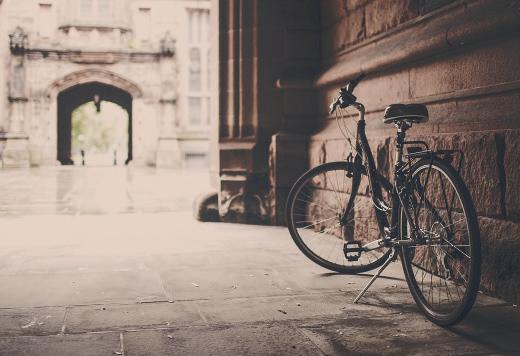 Jamie Bryson Features Writer
Jamie Bryson Features Writer
As a nation, we are cycling now more than ever before, with the latest Department for Transport statistics on road traffic (July 2023) showing the number of miles travelled on pedal bikes in 2022 totalling 3.9 billion miles. This represents an increase of 12% from the average per year between 2015-19. Whilst some councils and local groups have made efforts to improve cycling infrastructure accordingly, many of the UK’s cities are undoubtedly unfit for purpose - putting cyclists, pedestrians and drivers at greater risk.
What has happened?
Over the past year, I’ve been hugely struck by the number of reports of cycling accidents and even fatalities on the roads I know so well here in Norwich. Three cyclists have tragically lost their lives in Norwich, in the past nine months alone, and several others have been seriously injured.

In February this year, a cyclist in his 30s lost his life on Farrow Road - 5 minutes’ walk from my old front door. A couple of days later, in March, another man was killed on his bike in Watton. In August, a woman in her 60s died whilst cycling on Newmarket Road, where my grandma used to walk me into the city as a kid. And just 24 hours later, another rider was seriously injured on Kett’s Hill Roundabout - less than a fortnight after it was reopened following a £64,000 redesign that supposedly makes it safer for cyclists and pedestrians.
Fifteen cyclists have been killed in Norfolk over the past ten years, alongside 500 seriously injured. Something is clearly going wrong. ...and what about the national picture?
The number of cyclists killed or seriously injured across the UK rose from 5,102 in 2021 to 5,602 in 2022.
In London - where figures are measured separately - the number of people killed or seriously injured increased by 11%, from 3,580 in 2021 to 3,974 in 2022.
Key to this - walkers, cyclists, and motorcyclists continue to be most at risk, making up 80% of those killed or seriously injured in the capital in 2022.
Why has this happened, and what can be improved?
It’s a well-known fact that the majority of accidents between vehicles and cyclists and pedestrians are caused by dangerous driving. Indeed, two of the three fatal accidents in Norwich have been put down to dangerous and reckless driving (the most recent case is still undergoing investigation). This most commonly involves
speeding, distractions such as using a mobile phone at the wheel, and not giving cyclists a wide enough berth when passing them.
As part of Norwich Green Party’s 3-point proposal, city councillor (Wensum ward) Liam Calvert suggests, “Firstly, we need high-quality routes physically separating those on bikes from the dangers posed by vehicles. Secondly, we want to see urban street limits of 20mph, especially where full segregation has not yet been achieved, with a significantly increased enforcement of these limits. Finally, a reduction in traffic on smaller residential streets where people live so that they can leave their homes without the safety concerns that high traffic volumes create,” adding, “People shouldn’t have to fear for the safety of loved ones as they make everyday trips across the city.”
Furthermore, Derek Williams of the Norwich Cycling Campaign commented, “The city can’t handle the amount of traffic it sees at the moment; we need proper infrastructure and enforcement for those who drive dangerously. Norfolk County Council spent all that money on Kett’s Hill [round-
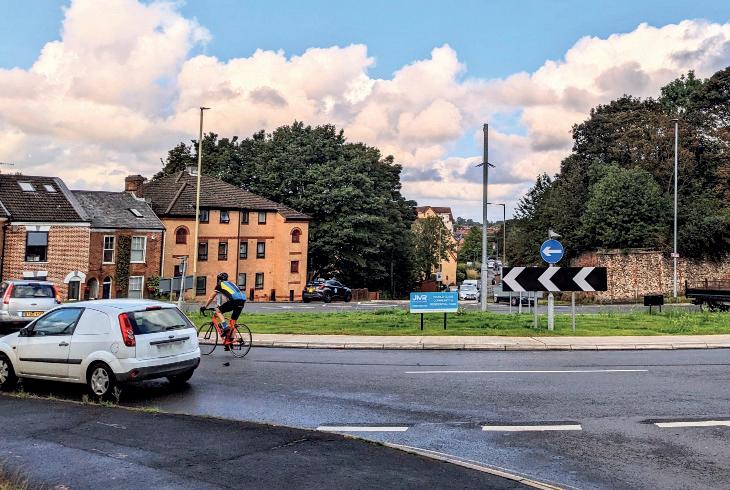
tragically lost their lives in Norwich in the past nine
about] and didn’t build a cycle track. This was done under the ‘Developing Cities’ fund, which is supposed to improve things for cyclists, but there is nothing there at all - it’s just pavements”.
Whilst dangerous driving undeniably remains the most significant threat, our roads have also seen an increase in cycling for professional use and commuting - including delivery workers. Across the nation, however, we see very little funding going towards improving cycling proficiency and knowledge of this part of the highway code. There is currently little to no proven evidence in the public domain suggesting unsafe cycling is contributing to these increased dangers at present; however, anyone who has driven in and around Norwich recently will have likely noticed quite some cyclists using their mobile phones, not indicating, entering the wrong lanes and not using lights and helmets. If we take this issue as seriously as it deserves to be, then we should also consider whether our cyclists have adequate awareness and knowledge of the Highway Code. Local and national gov-
ernments should subsequently consider investing in better ways to teach this from a young age and beyond. Furthermore, the government should consider reviewing the rules and regulations governing the operations of large food and grocery delivery companies and ensure their delivery workers adhere to the highest road safety standards.
Several individual improvement schemes have been constructed in the city over the past 18 months. However, questions and criticisms continue to be raised regarding both the ability to enforce some measures (such as 20mph zones) and the adequateness of new cycle lanes. Several city councillors, have recently emphasised the effectiveness of the separate cycle lanes (marked with reflective traffic posts) now in place on Plumstead Road (Thrope Hamlet) and part of Earlham Road (University Ward)
What funding is currently in place to help improve safety?
Norfolk County Councilresponsible for all county highways- received £46m as part of the Transforming Cities project between 2019 and 2020, followed by a further £3m from the Active Travel Budget this year. NCC said the funding continues to go towards work on bus lanes, pedestrian facilities and general safetyall contributing towards improvements for cyclists around the city.

Councillor Graham Plant, cabinet member for highways, infrastructure and transport, said: “We’re sorry to hear about the death of anyone on our roads. We are constantly working to improve highway safety whenever we receive funding to improve the network” and adding, “In terms of improvements for pedestrians and cyclists, not only are we in the final stages of implementing phase one and two of the Transforming Cities funding, but we were recently awarded £3m of Active Travel funding for schemes around the county. This is three times as much as the previous allocation, which is a very welcome addition.”
In May, plans were proposed for a £4m project on Dereham Road to include new bus, taxi and cycle lanes leading out of the city.
For updates on the latest safety improvement works: https:// www.norwich.gov.uk/cycling You can contact your city councillor by entering your (Norwich) postcode here: https://www.gov. uk/find-your-local-councillors

6 19th September 2023
Image: Concrete/Jamie Bryson - Separate cycle lanes with reflective posts on Earlham Road
FEATURES
Image: Concrete/Jamie Bryson - Newly referbished Kett’s Hill Roundabout
Image: Pixabay
UEA lecturers throughout the years
One of the most important aspects of any university is the academics and professors, as they influence the research and learning available to students.
On UEA’s 60th anniversary we’ve highlighted three professors who have contributed something extra to the university in their time.
***
Professor Malcom Bradbury launched the UEA Creative Writing MA in 1970. The first ever creative writing course in the UK during his time as a Professor of American Studies (1965-1995).
This course has been attended by the likes of Ian McEwan and Kazuo Ishiguro and is widely regarded as the most prestigious and successful in the country.

Alongside founding this monumental course, Bradbury published his first novel, “Eating people Is Wrong” in 1959, the first of eight novels across thirty-three years. In 1991 he was appointed CBE and knighted in 2000.
***
Professor Claire Jowitt served as the associate dean for research between 2015 and 2022. She now works across both the School of History and the LDC school as a professor of Renaissance studies.

Her most recent research falls on the Gloucester shipwreck to build a comprehensive picture of life on board and its impact.
Speaking to Concrete she said ‘My work on the Gloucester warship, has been my career’s most exciting research project. It’s been a privilege to share this work in a recent blockbuster exhibition, and to collaborate with the wreck’s
discovers, Norfolk Museums Service, and the Gloucester 1682 Trust.’
In May she was elected to the Society for Nautical research for her contribution to the Gloucester shipwreck project.
***
Professor Ben Garrod started his journey in academia with his BSc in Animal behaviour at Anglia Ruskin, followed by an MSc in wild animal biology at the RVC and finally a PHD in evolutionary biology at UCL.
He has been a Professor of Evolutionary Biology and Science Management at UEA for almost five years and has been involved in broadcasting since 2014. This all started with an award-winning series on BBC4 titled- Secrets of Bones.
Since then he has continued to present many shows as well as writing several books covering a range of topics.
“A phenomenal performance”- UEA’s University Challenge team take the lead

Taking on the University of Strathclyde two weeks ago, the UEA’s team won their first round of the University Challenge with 235 points. This represents the first time since 2018 that the UEA has made it through the first round of the show. Concrete’s Features Editor sat down with some of the team to discuss the show, quizzing and more… How did you get involved with the team? Had you watched the show before?
Owen Tobin: “Me and my family always watched the show so even if we never got on, I thought it would be a cool opportunity to meet some people and have fun doing some quizzes. I was the reserve for last year’s team when we applied, and I decided to give it another go this year to be on the team.”
Bryony Yates: “I joined the quiz society this year, but I’d always had University Challenge on my radar. I didn’t have enough time to do it in my undergrad so I thought it would be good to do during my PHD years.”


Matthew Jennings: “Me and my family always took part in quizzes as part of a social club, when lockdown happened and we couldn’t do it socially, I thought about trying out for the team. I found it to be more up my alley and it I don’t have to know much about recent events, more about dead people really.”
Was it all just memorization? Or was there anything specific you did to help prepare for the first round?
Tobin: I’m more of a word-association person, so I tried to come up with little words or phrases than would ping in my brain if I heard the words, which was good for the buzzer questions.”
Yates: “I made lots of immense PowerPoints for topics like art or music to help recognize the style. Also, I’m in the lab a lot so, while I was pipetting, I would always have podcasts on my headphones to try and expand my knowledge as much as possible. We would practice twice a week- once as a team and once with the quiz society event.”
Jennings: “I had a mixed approach and spent a lot of time
on Wikipedia, which can be good for a base level understanding of stuff. My mum tells me I’m good at picking up on information that no one else really cares about… I guess that’s quite a useful thing for this show.”
How does it feel to represent the UEA on the show?
Tobin: “We might not be one of the unis that’s on it year in, year out, but we think this is a great opportunity to promote the university and get the name out there.”
Yates: “Hopefully next year, and following, more and more people will want to get involved.”
How was the TV experience?
Tobin: “They made us feel like an integral part of the show and you weren’t just any other team. Also, taking the train together to and from the show was
trip, but you go live and have loads of people watch you.”

Jennings: “That sounds like the worst school trip I’ve heard of. We looked on Twitter afterwards and we read through all the comments people had put during our episode.”
Yates: “Yeh there was a lot of discourse on both your hair. For me it was just really cool to be on the set and meet Amol Rajan.”
What do you think was your team strengths?
Tobin: “I think it flowed well as we were a very collaborative team, and we didn’t have just one domineering person.”
Yates: “I think with the bonus
round questions we either get them all or we don’t really get any. Then sometimes we have to start making up Italian names ha-ha.”
Anything else to add?
Tobin: “I think I’d like to tell people that you don’t just have to have memorised a bunch of facts, it’s also about how you work and gel with the team.”
Yates: “I also think it’s more modern now-a-days and represents the diversity of the British student population, which is really good to see. It’s not just people in suits anymore.”
For those interested in being part of the UEA team for the next series of University Challenge, the UEA quiz society will start hosting try-outs later on this year.
a really great bonding experience. It was a bit like a school
19th September 2023 7 concrete-online.co.uk/category/features/ | @ConcreteUEA
Image: UEA - Prof. Claire Jowitt
“It’s not just people in suits anymore.”
Image: BBC/University Challenge
Eleanor Radford Features Editor
Eleanor Radford Features Editor
University Challenge on my radar”
Home of tHe Wonderful
A Brief History of UEA: 60 Years of Doing Different
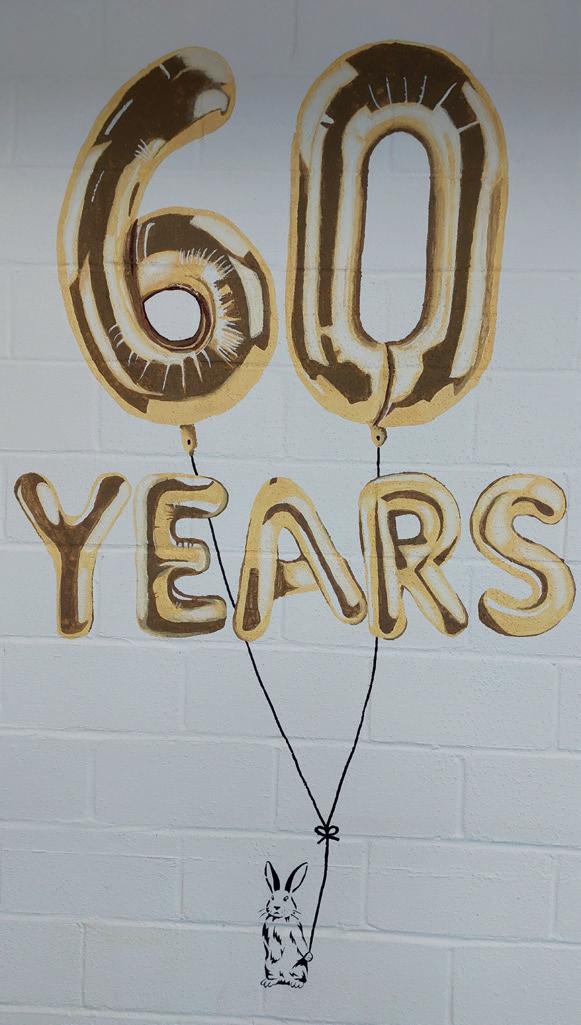 Matthew Stothard Co-Editor-In-Chief
Matthew Stothard Co-Editor-In-Chief
The University of East Anglia was officially opened on 29th September 1963, in a University Village intended to be temporary (although it remained open for 30 years!). Attempts had previously been made to lobby for a university in Norwich in 1918 and 1947, but it was the 1958 movement spearheaded by the Chief Education Officer for Norfolk, Dr Lincoln Ralphs, and a Director of Colman’s, Andrew Ryrie, which had led to this moment. The name was chosen in 1959 to reflect the fact that the Norfolk and Norwich authorities could not fund the new university alone. In addition to funding from across the region’s councils, a large-scale fundraising campaign gathered capital from across the social scale, from the Royal Family to local businesses and poorer locals.
UEA was approved by the University Grants Committee in 1960 and historian of America Frank Thistlethwaite was appointed as Vice-Chancellor in 1961. The first intake in 1963 was made up of 112 students who took courses in either Biological Sciences or English Studies (an amalgamation of English and History which reflected Thistlethwaite’s interdisciplinary vision). Schools of European Studies (combining literature, history and languages), Social Studies, Chemistry, Physics and Mathematics all followed in 1964, while 1965 brought Fine Arts and Music with Benjamin Britten as Music Advisor. 1967 saw the opening of the School of Environmental Sciences. The brainchild of Solly Zuckerman, its combination of earth sciences and geography was the first of its kind in England.
The 1960s also saw the development of the campus on University Plain, as we know it today, by Denys Lasdun (to whom the acronym UEA can be credited as it appeared on his plans). Norfolk and Suffolk Terrace opened in 1966, with names that had been proposed
by Ryrie back in 1959 to try to win over those in Ipswich and South Suffolk who were less inclined to support UEA. The first half of the Library was opened in 1968 (and was completed in 1974). The Teaching Wall was gradually developed across the decade, with Chemistry opening first in 1966 and ARTS II completing Lasdun’s
time on the project in 1970. Student life at UEA developed as the 1960s progressed with the foundation of the Students’ Union. The first student newspaper, Mandate, was launched in 1965, and the end of the decade saw a period of unrest, including political protests, such as those against the visits of Princess Margaret and Elizabeth II in 1968. Meanwhile staff enjoyed a Senior


arrival of Politics, Film Studies and Drama, whilst Schools of Computing, Education and Law were also opened. Professor Thistlethwaite resigned in 1980 and was replaced by physicist Michael Thompson, who presided over a period of Thatcherite cuts and a nationwide drive towards the sciences. Whilst UEA did move somewhat in that direction, it remained dominated by the arts and social sciences. Other developments of the 1980s included Law moving into Earlham Hall, the donation of the East Anglian Film Archive to UEA and the opening of the Education building (now the Laurence Stenhouse Building) in 1984, as well as the arrival of module feedback forms. In 1987 biological chemist David Berke took over as Vice-Chancellor.
1990 brought with it Livewire and The Waterfront (which the SU took over in 1993), whilst the Norwich Research Park opened in 1992. Also in 1992 was the launch of the current iteration of Concrete, and our first front page reported on the university’s move from a threeterm to a two-semester year, alongside the introduction of
who preferred to remain with the literature scholars). There were more new buildings as the Drama Studio opened in 1994 and Elizabeth Fry in 1995, as well as changes in leadership with two figures from outside higher education becoming Vice-Chancellor (Dame Elizabeth Esteve-Coll in 1995 and Vincent Watts in 1997), in addition to the advent of the School of Management in 1996 (to become Norwich Business School in 2005).
That brings us to the 2020s, which have not been a smooth ride for UEA so far, with the universal challenges brought by COVID-19 and the financial challenges of 2023. Other events have included the opening of the School of Engineering, the move from the ARTS building to the former Registry (now AHB) and the arrival of new ViceChancellor David Maguire. With UEA now developing its 2030 Vision, the next 60 years will surely be as eventful as the last!
The 1970s opened with the founding of the Creative Writing MA program, as well as the first staff strike, with the BIO faculty protesting university car parking charges. The Climatic Research Unit was established in 1972, whilst Union House (including the LCR and SU Bar), the Street and the careers service were all opened in 1973. The Sainsbury Centre was opened in 1978, whilst the UEA Broad was completed in the same year. UEA gained the Broad for free, as it was excavated simply in return for the gravel which was collected! The decade saw the
modules and credits. In 1993, the SU banned Nestle products from its retail outlets, and new accommodation was developed as Constable Terrace and Nelson Court were opened, and UEA bought back part of the original University Village site it had sold off in 1989 to begin constructing the Village accommodation.
Although there had been a History degree for a number of years, combining courses from across the Schools of English and European Studies between which the historians were divided, it was only in 1994 that a united School of History was established (with the exception of the American historians


At the turn of the millennium, the Sportspark opened, the Tyndall Centre for Climate Change Research was established and semesters became 12-weeks long as they are today. In 2002 UEA gained its Medical School (an idea which had first been suggested back in 1964 by Thistlethwaite), with the School of Pharmacy following the year after. In the 2000s the university expanded its horizons, opening University Campus Suffolk with Essex in 2007, INTO in 2008 and the short-lived UEA London in 2009. The decade also saw the combination of schools into the four faculties in 2004, and three new Vice-Chancellors, economic geographer Bill MacMillan in 2006 and two historians – David Eastwood in 2002 and Edward Acton in 2009.
The 2010s saw the development of the campus portfolio with new buildings including Thomas Paine (2010), the Julian Study Centre (2013), Crome Court (2014), the Enterprise Centre (2015), Hickling and Barton (2016) and NEWSCI (2019). Concrete launched our current arts supplement Venue in 2010, whilst in the faculties the Music School was closed and in 2014 some of the humanities schools were combined to form AMA and PPL. Biologist David Richardson became ViceChancellor in 2014, whilst 2015 saw the Sainsbury Centre making its first appearance as Avengers HQ.
This article would not have been possible without Michael Sanderson’s book, ‘The History of the University of East Anglia, Norwich’ (2000), and the hard work of Concrete’s reporters over the last 31 years.
19th September 2023 8
Photo 1: Construction of Nelson Court, 1992
Photo 2: Concrete Editors looking around the building works of Nelson Court, 1992
Photo 3: UEA 60th Anniversary Sign in the Student Union
“The American historians[...] preferred to remain with the literature scholars”
“The first intake in 1963 was made up of 112 students”
Common Room complete with its own wine store and butler!
Photo: Concrete/Matthew Stothard
Picture Credits: Concrete/Steve Howard
Photo: Concrete/Thuy La
A lumni memories
“I met my now husband and business partner in my first year at UEA. We’ve just celebrated 10 years together. From barbecues around the lake, house parties at the zigs and gigs at the LCR, to hours dedicated to the library top floor...”
I think one of my favourite things about UEA was all the natural beauty on campus – the wildlife, the bunnies, the lake and the woods – everyone seemed a lot more relaxed than they might usually be. Also, in times of need, students and staff pulled together as a whole – a community of hopers and dreamers.
Chris
Matthews--News Reporter for MailOnline, former Concrete Editor-in-Chief
“ENV at that time was a very small department and a bunch of fellow students fostered an interest in the wilder East Anglia, with Bird Club mini-bus trips often being mostly filled by ENV students. It was a good studying environment and I thoroughly enjoyed my time in ENV with hands on soil science trips being some of the highlights.”
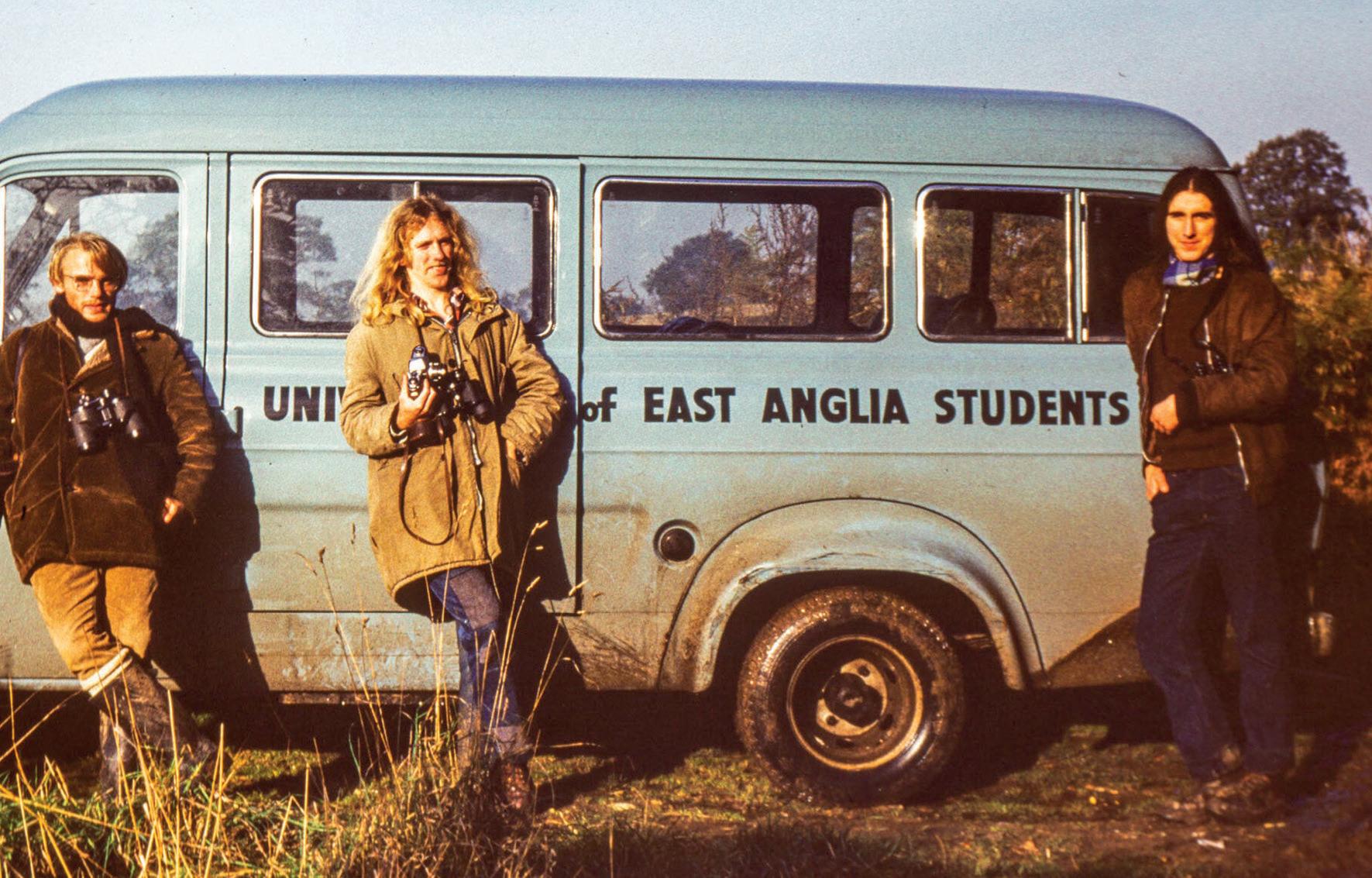
When I think of my time at UEA, it’s my favourite places on campus that spring to mind. Whether it was my tiny room in the University Village, barbecues with friends at the lake, sunbathing in the grass outside the famous Ziggurats, drinking coffees in the Square while sheltering from the rain and reading essay feedback, or running from pints in Red Bar to join the endless LCR queue, it always felt like home.
Jessica Frank-Keyes-- Political Reporter at City AM, former Concrete Deputy Editor.
“It was a home away from home, and Norwich really gave me the opportunity to leave the safety net of home, without being too far away. UEA gave me friends for life. It gave me a network. I’m still very good friends with a lot of people I studied with.”
“Being part of Concrete was genuinely life changing. I chased Stephen Fry across campus, reported from a kitchen missing a window following a big storm and got a front row spot to photograph both Busted and the Queen.” (Megan HarwoodBaynes, Social affairs and health reporter at Sky News, former Concrete Editor-inChief)

9 19th September 2023
Thuria Wenbar -- CEO of Evaro and recipient of an Innovation and Impact award in 2019. Thuria graduated from UEA with a medicine degree in 2017
Davina Tijani – Data Operations Manager at Imperial College London & Writer. Davina graduated from UEA with a BSc in Actuarial Science in 2017
Graham Catley -- studied Environmental Sciences from 1972-1975. Graham has a photography website and a blog page. (https://www.uea.ac.uk/stories/graham-catley-a-life-in-photography)
Picture Credits: Concrete/Megan Harwood-Baynes
Picture Credits: Graham Catley
Home of tHe Wonderful The Welcome Festival: It’s What You Don’t Expect
Fiona Hill
Home of the Wonderful Editor
There is no doubt that the UEA plans the Welcome Festival meticulously. There are so many events in fact, that if you wished, you would not have to spend one moment alone for the whole fortnight. In several ways this will be a comfort to many, allowing for the most possible opportunities to meet new people, try new things and fight off that uncomfortable feeling of being alone, possibly for the first time in your life. Although I’d be lying if I said that there weren’t some expectations to enjoy a club night every now and again, there truly is a bit of something for everyone, from the classic ‘Welcome Party’ and ‘Glow Party’ at the LCR on the 17th and 18th to the ‘Chill Day’, full of arts and crafts on the 22nd.
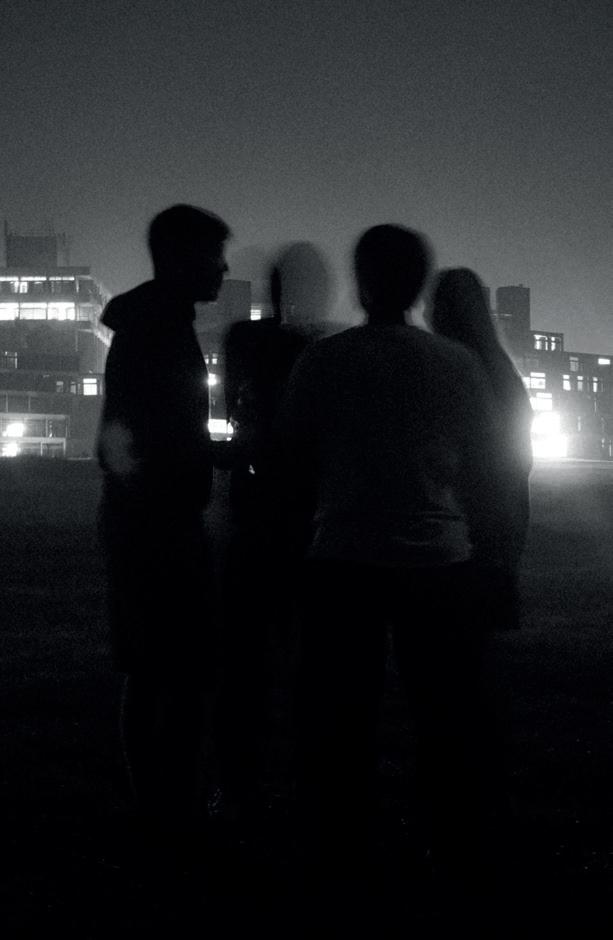
However, if you’re a firstyear reading this, I imagine that you’ve already seen
the UEA SU website and have ploughed through all the events that you’d be interested in. Nevertheless, the full extent of what is on offer doesn’t stop there. If you fancy something more laid back than the full-scale events, why not try getting to know the local area better through Navigate Norfolk’s trip to the coast on the 16th, the wellbeing dog walk on the 20th or either the Sheringham Beach clean or the Day Walks trip to Marston Marshes, both taking place on the 24th. Throughout the fortnight there are also sports taster sessions and try-outs to get involved in, making the Welcome Festival the perfect time to find a new sport, no matter your ability. Society events are also abundant throughout the Welcome Festival, with some, such as the Drama and Musical Theatre’s society’s PANTS performances on the 22nd and Ghost Hunting Society’s Tarot taster session on the 26th, being shown on the SU
website. Other society events may be more challenging to find and therefore, if you have a specific society in mind, I highly recommend checking on their social media for events or looking out for them at the Welcome Fair on the 20th. Despite similar happenings taking place last year, it was not any of the events at the LCR, the club nights or the pre-drinks that has stuck with me (although I am envious of all the fun the first years have in store!). Instead, it was the time that I took alone to explore the library. In a period when you feel submerged with other people, I can’t express how important it was to me to take some time out, to process all the changes that were happening and to find something that was vaguely familiar, something that grounded me back towards myself. Whether that’s the library for you, a quick stroll around the lake or even an hour or so listening
to your favourite music, don’t feel guilty about taking time to yourself in Welcome Festival; I’d say it’s essential.
People often repeat the ageold cliché that you won’t make lasting friendships in ‘Fresher’s Week’, but I can’t see much truth in this. If you look
out for things that suit you, in addition to trying things that might be slightly out of your comfort zone, what’s stopping you? Although if it doesn’t go exactly to plan, remember you’ve got at least 24 more weeks at UEA this year to change it around!
Photos: Concrete/Innes
Concrete Archive: 30/09/1992
Matthew Stothard Co-Editor-In-Chief
To start our explorations of the Concrete Archive, we are going to delve into our very first Freshers’ issue from September 1992.
The front page was dominated by stories affecting the new students, as the Student Union condemned a letter sent to Freshers by the university asking for an advance rent payment. The SU felt this was in response to the threat of a rent strike, which the university denied. The SU also disputed the value of changes which had been made to campus, including a sunken garden at the end of the ARTS building, a refurbishment of the Registry and new pathways. The SU were facing their own problems too though, as sending their ‘Welcome booklet’ late to the printers meant they had to pay £2100

in postage (as they arrived too late to be sent out with UEA’s welcome information).
Inside the issue are reports on lots of developments which still impact UEA today. Concrete’s Publisher and Editor were the first students to enter Nelson Court as it was being built, getting to see what they termed “the controversial en-suite bathroom units.”

Meanwhile, construction was starting on the ‘UEA Studio’ (now the Drama Studio), and there were changes for Concrete too, as we moved from ARTS 2.29 into Union House for the first time.
We also reported how the SU had spent £15,000 on new disco lights for the LCR, raising admission to their discos to £2 to fund the expense.
Meanwhile, in the city centre, Castle Mall (now Castle Quarter) was reaching the final stages of its construction, concluding the £125 million
project!
Jody Thompson had plenty of advice for incoming Fresher’s in her ‘survival guide’ to UEA. She suggested they should “have a cardboard sign to hang around your neck” to answer common questions like where you come from and your degree, but they should not “walk around Norwich market alternately laughing and loudly attempting the local accent as you’ll be shown just how effectively and swiftly a cucumber can be forced into an orifice”!
Those may be more tonguein-cheek but her final advice largely remains true: “don’t forget to play hard and work hard, be nice to each other and your tutors, drink Lucozade Sport for hangovers, get the bank manager under your thumb [less sure of the relevance of that one today!], and leave the rabbits alone.” Has anything really changed?
19th September 2023 10
Issue 10: 30th Septmeber 1992,
Ed. Peter Hart
Global
Growing religious intolerance
Syed M Hamza, MILT (UK)
Global Editor
“You may belong to any religion, caste or creed— that has nothing to do with the business of the state.”
These were the words spoken by Muhmmad Ali Jinnah, founder and first GovernorGeneral of Pakistan, more than 7 decades ago. The significance of these words could not have been more relevant to global politics considering the recent unfortunate events against certain faiths. Al Jazeera confirmed – a person, Salwan Momika, desecrated the Holy Quran whilst tearing and burning pages of the holy book in front of a mosque in Stockholm, Sweden. Momika carried out this action during Eid ulAdha which is one of the two Islamic holidays celebrated globally each year by Muslims.
United Nations Human Rights Council condemned the burning of the Holy Quran. On 12th July 2023, the council adopted a resolution to firmly reject the advocacy of any action associated with religious hatred. The countries that voted against the resolution included United States, United Kingdon, France, and Germany. Muslims are not the only ones being subjected to stereotyping as religious hatred does not have any boundaries. In England and Wales, official statistics from the UK Home Office confirm a 26% rise in hate crimes compared to the previous year. The Home Office data also suggests that in England and Wales, out of approximately 8,307 religious hate crimes, 42% targeted the Muslim community whereas 23% of the victims belonged to the Jewish community.
According to the Guardian, Manipur – a state in India – has been experiencing extreme
ethnic violence since early May resulting in the burning of around 250 Churches. British MP Fiona Bruce, Chair of the 42-country International Religious Freedom or Belief Alliance, raised the issue in the British Parliament. The honourable MP, whilst citing a report, said, “It indicates that since early May alone, hundreds of churches there have been destroyed, many burnt to the ground; more than 100 people have been killed and over 50,000 displaced; and schools and seminaries have been targeted in what looks like systematic and premeditated attacks with religion a key factor”.
Amidst the recent French ban on school children wearing the abaya, a long overgarment usually worn by Muslim women, there was an incident in which a 15-year-old girl was denied school entry. The reason for this was her wearing of a Kimono, a cultural clothing of Japan that does not represent any religion. It is astounding
to recall that decisions of world leaders themselves have contributed to the phenomenon of “Islamophobia” or fear of Muslims. During an interview with Fox news, Hiliary Clinton, Former U.S. Secretary of State, admitted, “Because when the Soviet Union invaded Afghanistan, we had this brilliant idea that we were going to come to Pakistan and create a force of mujaheddin, equip them with Stinger missiles and everything else, to go after the Soviets inside Afghanistan”. Former U.S. Secretary of State also added, “Now you look back; the people we’re fighting today we were supporting in the fight against the Soviets”.
The way forward should be to ensure a world environment which promotes wellbeing and freedom of people of all faiths. We ought to be cognizant of the fact that no religion is inherently violent. Every person should have the right to practice any religion. There is a stark
difference in freedom of speech and hate speech which should be reinforced by the international community. Such social issues are sensitive, intricate, and divisive. As a result, they can only be resolved through consensus amongst world leaders who should also be mindful of not using religion to win wars as reminded by the remarks of Hilary Clinton.
Picture Credits: Unsplash
Northern Ireland’s Police Chief resigns after data breach
Sankavi Naresh
Senior Global Writer
Chief Constable of Northern Ireland’s police force, Simon Byrne, has resigned after the Police Service of Northern Ireland (PSNI) experienced a serious data breach, details of about 10,000 officers and staff were released to the public.
The after-effects of the data leak have escalated the mounting pressure on Simon Byrne to resign and his leadership has come under scrutiny in the wake of a severe security lapse.
The data breach follows a string of controversies during his tenure. In 2021, two junior officers at a Troubles memorial ceremony were found to be unlawfully disciplined by Byrne. This action was believed to have been made to mitigate backlash from Sinn Féin, which is Northern Ireland’s biggest republican party. Sinn Féin denied any involvement in the matter. Furthermore, an individual has been arrested upon being found to have been collating the leaked data, which could possibly be exploited by terrorists. Serious concerns have been raised about the
safety of police officers in Northern Ireland as the threat level towards the force has been assessed as “severe”. This hints at the onset of 5th generation warfare tactics in an increasingly digital world where people utilise new technology in order to carry out radical attacks.

Northern Ireland’s turbulent relationship with the police has been marred by ‘The Troubles’, a period in which the predominantly Protestant unionists, who wished to remain a part of the United Kingdom, had conflict with the predominantly Catholic nationalists who sought after a United Ireland. During this period, the Royal Ulster Constabulary (RUC) served as the primary law enforcement agency in Northern Ireland. However, the RUC was subjected to criticism and allegations of bias, particularly from the nationalist community. Many saw the RUC as a symbol of unionist dominance - this led to rising tensions and a lack of trust in law enforcement.
The Good Friday Agreement was signed in 1998 and marked a turning point in Northern Ireland’s history. The agree-
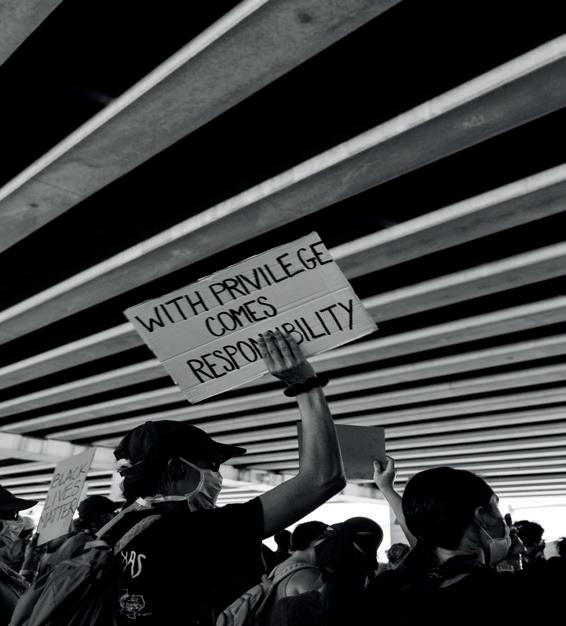
ment aimed to put an end to ‘The Troubles’ and established a government which shared power between both nationalists and unionists. Part of this agreement included police reform. In 2001, three years after the Good Friday Agreement, the RUC was disbanded and the PSNI was formed. The PSNI was envisioned as a more inclusive police force.
As a consequence of the data breach and previous controversies, morale within the force and the communities it serves are at alarming lows. According to a LucidTalk poll conducted in 2023, only 16% of people in Northern Ireland had confidence in Simon Byrne’s leadership of the PSNI compared to 60% who expressed no confidence. Police Federation Chair, Liam Kelly, states “Morale has never been lower in the Service. There is a serious and worrying disconnect between those in leadership roles and the men and women from all community backgrounds who are the rank-and-file…”.
A statement issued by the Superintendents’ Association of Northern Ireland establishes that the chief constable’s resignation ended a period of “worrying uncertainty and great disquiet” within the service.
Picture credit: Unslpash
11
Co-Editors-in-Chief, Matthew Stothard with Professor David Maguire,
Professor David Maguire became ViceChancellor of UEA in May this year. He has presided over a turbulent time for the university, joining mid-way through the Accelerated Strategic Review Program which aimed to reduce UEA’s financial deficit. However, when we met with him he was keen to start looking forward, suggesting that “we’re turning a new page to start a new chapter. The last six months have been pre y horrid, but it’s something we needed to do because we got into a di cult position, but now I think that’s behind us and I’m certainly looking forward with renewed enthusiasm to a more prosperous future for us.”

***
We started by asking Prof. Maguire what brought him to UEA, and he told us he’d “always been impressed by the quality of research and teaching that takes place here. It’s an amazing location so I was only too thrilled to be given the opportunity to come and work here.”
Now as we enter a new year o the back of sta reductions, we then spoke about what the university is doing to reduce the impact of these cuts. He made clear “it’s still a work in progress, and it is regre able that we’ve had to quickly reduce sta numbers.” However, he also highlighted that the sta ng levels were still on par with peer universities across the country, suggesting “our sta -student ratio is actually still one of the be er in the sector, and whilst there will be some gaps in some areas which we need to work on, I feel as though we’ve got su cient sta resource and we’ve still got great facilities here. There is a period of readjustment, but we’ve got every prospect of continuing to deliver world-class teaching and learning opportunities for the students.”
He added that the university has found all “the expenditure reductions we needed to make for this year… We are ahead of our plan and we’ve had a really good recruitment round for the coming Autumn” (see page 4). “We’re not completely out of the woods, it will probably take two to three years to finally get the monkey o our backs and be into a place where we can be really confident about our long-term stability, but I think we’re able now to plan a bit more strategically, a bit more purposefully, a bit more carefully about how we make choices for this year.”
Throughout the ASRP, the arts and humanities were often at the centre of the conversation as the most academics were put at risk of redundancy at the faculty. UEA has a strong reputation in the area, and Prof. Maguire did emphasise that “arts and humanities are amazing, and we’ve got some incredible people here who’ve done brilliant work and we have a fine reputation for that without question,” but he ‘slightly
disagreed’ with the idea the university’s reputation was built on that alone, pointing to strengths across all the faculties which the university hopes to grow in the future.

He said that the idea the cuts have di erentially impacted the arts and humanities is “a myth.” He highlighted that the highest sta reductions were made in Professional Services, and that “all four of the faculties have been asked to make savings in order to keep the university on the straight and narrow, it’s just that I think they were seen slightly more visibly in arts and humanities because other areas managed to do it through other means. They were, if you like, more proactive, or perhaps had other opportunities that weren’t easily available in arts and humanities. [He clarified that other faculties had been able to find savings through “less intrusive means” like voluntary severance and vacancy management, as well as cuts to non-sta costs.] So I know it looks like there were more di culties there but actually it’s been spread across.”
Prof. Maguire also told us UEA will be “relaunching the arts and humanities,” this autumn, “to make sure we highlight the strength of the people and the work that we do,” although precise details for what that will involve are still in development. He said, “I want to talk up arts and humanities, because of the quality of the work it does now and will do in the future, not dwell on the recent past.”
He emphasised that, across all subject areas, “we need to be talking up the university much more and really ge ing our message out. We’re doing some fantastic stu here and sadly lots of people don’t know about it outside those of us who work and study at the university. So that’s a big thing that I’m trying to bring – get really clear about what our story is and where our successes are, and then be really good about telling the world about it, in the hope that our reputation will rise and the number of people who want to come and study and work here will also increase.”
With the di cult year UEA experienced before the change in management, it was important for us to ask how Prof. Maguire sought to restore sta and students’ trust in the senior leadership team. The ViceChancellor questioned whether trust was low, suggesting “a lot of this [concern] is based on rumour and myth” and that whilst he accepts his job is “always to maintain the trust of all the students and sta , [...] I’ve just got to do my best to lead the university as best as I can.” He stressed that building this trust with students and sta was a “process, not an event, [...] I’ve got to keep doing the best that I can do and hope that people find that satisfactory and believe we’re going in a positive direction.”
Reflecting on the past year, Prof. Maguire
stressed that ‘More than a third of [students] are about to arrive and are not encumbered with history. They’re coming with a fresh face, and we need to get them o on the right, positive foot about what a great place this is. [The university] is an amazing place doing brilliant things, and we’ve got a chance to reset and restart, and turn a page forward.”
When pushed about what he is doing to restore trust with returning students, Prof. Maguire pointed out he’d met “multiple times with the Student Union and engaged regularly[...] with sta and students on campus”. He spoke about being present at one of the university’s open days and going out whenever possible to “meet people and listen”. In addition, he said himself and his colleagues were in the midst of a “big consultation around the strategic plan” whereby he’d be meeting people “inperson and online to try and get some feedback and direction from students”. He stressed he was “all about engagement with students”, who he described as “key partners” for many activities on campus.
In line with discussing the needs of students and sta , we asked how Prof. Maguire was intending to support the wellbeing of the overall university, particularly in the midst of the cost-of-living crisis and the after e ects of COVID-19. He acknowledged the great impact these national issues were having on students, and explained his plan to “build up the capability in our student support services”. Prof. Maguire further commented that the senior leadership
19th September 2023 INTERVIEW
12
Photo: UEA
“I want to talk up the arts and humanities, [...] not dwell on the recent past.”
and Eve Attwood in conversation
UEA’s new Vice Chancellor
team work “closely with people in the UEA Medical Centre on campus” and in the midst of a rise in requests for extenuating circumstances, have sought to support all those cases “where we can and where it’s fair”. Keen to praise the Student Union, he described them as “our key ally in terms of helping deal with students” and encouraged students to “interact with advisors” on campus when needed.
During the last academic year, UEA participated in the national UCU strikes, which included 18 days whereby academic sta took to the picket lines. We asked about how the university would respond in the event that there were more strikes this year, to which Prof. Maguire responded “We have really good relations with the Union on campus, at least while I’ve been here, and we’re working really hard with them to avoid strikes in the first place.” He added that, in the event of strikes, “the impact on students will be of paramount concern and we will seek to do what we can to minimise that by pu ing alternative arrangements in place.” He reinforced that the aim of the senior leadership team was to “ensure an alliance and a partnership which means when the university prospers, sta and students prosper.”
As a new wave of students arrives this year, the university has already had to tackle some di culties. A statement was issued by the university in response to the Government guidance on RAAC (Reinforced Autoclaved Aerated Concrete) on the 8th September about some UEA student accommodation being closed as a precautionary measure while further investigations are to be carried out. As a result, Norfolk and Su olk Terrace (the Ziggurats) are currently closed, as well as the top floors of Nelson Court and Constable Terrace.
In response to this, Prof. Maguire explained a “preliminary survey of all the buildings on campus” had been completed and that “structural engineers [would be] on site[...] to confirm it is RAAC and to assess the state of the concrete”. He said it is only then that “we can determine what the best outcome is” and the next steps to take. He added that no one would be allowed back into the buildings “until we’re confident it’s safe to be there” and that the university has already agreed to find alternative accommodation for all those students coming this year who would’ve stayed in the Ziggurats. He spoke of the university agreeing that these changes should not “materially a ect students financially in terms of the ability to be successful academically. When they’re rehoused, they will be rehoused into higher quality, more expensive accommodation, but we will honour the agreed price they were originally paying.” He added that students having to transfer from o -campus onto campus will be provided subsidised transport.
On a lighter note, we asked Prof. Maguire what message he’d have to students joining UEA this year and his advice. He began by praising the university, claiming, “You’ve made a brilliant choice coming here and you’re going to learn the most fantastic things. If previous cohorts are anything to go by, you’ll make lifelong friends and learn all about yourself.” He was realistic however, claiming students should “be excited, be slightly scared about the prospect of coming, but in a good way[...] Realise that this is a complete set of new experiences and it’s right for you to be anxious, not everything will go smoothly. But what makes us all strong and what we learn from is all those adversarial situations where we can overcome those di culties.”
Circling back to the topic of mental health, Prof. Maguire highlighted that for any new students struggling, they should “talk to academic advisors, people in the Student Union[...] the university student services and if necessary, the medical centre.” He also emphasised the importance of contacting “family and friends and supporters back home – they’re all rooting for you and only want you to be successful.” His final piece of advice was simple – “Don’t forget to have a great time!”
As the university approaches it’s 60th anniversary, the 29th September, we asked Prof. Maguire his thoughts on UEA’s legacy. “At the outset, [UEA] was designed to do di erent,” he said, citing its Creative Writing course as “world-first”. He praised the university’s “global reputation for the quality of the research” and its work on “Arts and Humanities, Creative Writing, climate change, and medicine.” As well as that, he emphasised the list of incredible alumni, including those who have gone on to be nominated for awards such as the Booker Prize and Nobel Peace Prize.

In terms of the university as a location, Prof. Maguire was quick to comment on the campus’ “brilliant park” and beautiful lake. He joked that someone had said to him that “the best thing about UEA is the rabbits and the squirrels”. We can’t say we disagree!

19th September 2023 13 concrete-online.co.uk/category/interview/ | @ConcreteUEA
“The [university] is an amazing place doing brilliant things, and we’ve got a chance to reset and restart, and turn a page forward.”
Photo: Concrete/Matthew Stothard
Photo: Concrete/Prakrita Rahman
To SEND or to bury? The Tories and their tactics of avoidance
Lily Taylor Comment Writer / Music Editor
It was revealed last week that the government have quietly signed a contract agreeing to cut 20% of funding for children with special educational needs and disabilities (SEND), in a bid to bring down costs. SEND budgets have been a growing issue for many years now, due to an increasing demand against large financial deficits. In an aim to tackle this, the government have devised the Delivering Be er Value in Send programme (DBV), that encourages measures such as early intervention and placing children with special needs in mainstream schools. This, they believe, will help support a number of councils to cut their SEND budgets.

I spoke to a reception teacher about her stance on the DBV implementation. She considered the DBV to be naïve to the complexity of early intervention and misinformed about the di culties of teaching SEND children in mainstream schools. EHCP’s (Education, Health and Care Plans) provided by the government

do not cover SEND sta ’s wages, which means that the ratio of SEND sta to SEND children is highly unequal. Also, the average salary for SEND sta is low, at around £23,400 per year. It is possible to make more money working in Aldi than in SEND, which is why schools are experiencing di culty in finding people willing to fill these positions. As a result of this, many children who need one to one support are not receiving it, which in itself is hindering the e ectiveness of early intervention
In my opinion, paying these SEND workers such a low average salary is an u er disgrace. I’m not saying that working in a shop doesn’t have its challenges,
but working with a SEND child is entirely di erent. SEND workers are shaping lives for the be er, allowing SEND children and young adults the space they need to learn and have the best quality of life they possibly can. Without SEND workers, many children with special needs and disabilities will grow up feeling isolated, which could result in an overall lack of support and a decreased quality of life. The reception teacher I spoke to also argued that the impact of COVID-19 hasn’t been considered. The children currently in reception were born during the pandemic years, meaning they were born into the unconventional world of lockdown. As a result, the number of children who are emotionally underdeveloped has increased dramatically. Due to these children having di culties regulating emotions, parents are then searching for diagnoses. This means that teachers are having to support and provide evidence for a huge backlog of requested diagnoses without additional funding.
Considering all the political scandals that happened during the pandemic, you would
think that the Conservative Party would have recognised their failings and strived to do more for the people rather than themselves. However, their nonchalance to the post-Covid impacts once again proves that they are still failing society, especially families including SEND children and adults.
So, you may ask, who are the cuts really helping? Well, reducing SEND costs will evidently not help SEND individuals or those who care for them, no ma er what the government may try to make us believe. Instead, they will reduce tax costs for the rich, making them even richer. It is another disgusting choice made by the government, and Rishi Sunak has a lot to answer for.
The blurry future of ‘X’ and the death of the bird

Ore Adeyoola
Comment Writer/ Film Editor
On October 27th, 2022, billionaire and multibusiness owner Elon Musk purchased Twi er, Inc. for $44 billion, becoming the networking site’s CEO. In less than a year, Musk has made substantial notorious changes to the wellestablished platform. From enabling users to buy verification ticks through ‘Twi er Blue’, to rebranding the whole site as simply ‘X’, it is safe to say that Musk has caused quite a stir amongst Twi er/X’s dedicated user base.
Musk, a self-proclaimed “free-speech absolutist” has made Twi er/X a festering ground for bait accounts and borderline neo-Nazi indoctrination parading as ‘cultural awareness’. Twi er Blue’s payout feature is one of a few good updates that Musk has overseen on the platform. It allows Twi er users with X Blue to earn income based on interactions on their posts, which is great for creatives. However, even this update has unlocked a toxic new method to capitalise on outrage - bait accounts,
who will post purposefully insensitive or o ensive content to farm interactions from rightfully incensed users, and earn money for being a poison to the X-sphere.
The bumpy journey of Elon Musk as Twi er CEO came to a screeching halt in May 2023
when Musk decided he wanted to step down as CEO a mere six months after buying it. Like a child who is bored of their new toy, Elon decided that he no longer wanted to be “CEO of anything” and would instead be a chairman. He appointed Linda Yaccarino on the 5th of June of this year. With the current state of Twi er/X being so tumultuous, this has been speculated by some as a classic “glass cli ” move -- appointing a woman as head of a company when it’s failing, ultimately se ing her up for failure. Yaccarino’s priority is to make Twi er/X profitable for advertisers again- something Musk definitely didn’t help improve during his time as CEO.
In the midst of all the chaos around Twi er/X, many users fled to other similar social networking sites for stability and solace, in fear of the sites future. Well known sites like Tumblr, and lesser known sites like Mastadon and Bluesky saw a rise in their user base as established Twi er influencers diverted their followers to alternatives.
Meta CEO Mark Zuckerberg saw the Twi er exodus as an opportunity to debut his new Twi er alternative, ‘Threads’. The platform broke records due to its staggering user base in such a short amount of time, although of
course Zuckerberg had successful platforms with billions of users to advertise Threads to.
Although it had a strong start, many users quickly grew bored of Threads. The site was under-developed upon its launch, and missed what makes Twi er special. Threads allow you to follow everyone you have on Instagram upon sign upalready se ing it apart from Twi er which survives on interactions between strangers and not necessarily friends and family. The future of X/Twi er is blurry and unfocused. Undeniably, it has a strong user base that has stuck with the site through all its many changes and phases, and a worthy successor has not yet arisen. As the site becomes more moderated again and small improvements are made under Yaccarino’s reign, I’m left feeling a naive hopefulness for the future of my favourite social networking site.
COMMENT 14 19th September 2023
“It is possible to make more money working in Aldi than in SEND[...]”
Credit: Unsplash
Credit: Unsplash
The widespread neglect of social architecture and urban design
Sam Slade Comment Editor
Architecture and urban design have long been a powerful expression of human creativity, culture, and identity. Far more than just a utilitarian pursuit, they have shaped the fabric of our surroundings, evoking a myriad of powerful emotions, and influencing the ways in which we interact with our everyday environment. They have played an indispensable role in fostering a sense of place and community.
Meticulously designed public spaces can encourage social interaction, strengthen community bonds, and facilitate a sense of belonging. Conversely, poorly designed spaces can lead to feelings of isolation and disconnection.
A perfect example of this is the cul-de-sac, which emerged as a result of well-meaning post-war building legislation. It was originally theorised that this form of urban design would bring communities closer together whilst providing them with more privacy. The actual result was sprawling estates, which as described by David Rudlin, chair of the academy of ur-
banism, “make walking inconvenient and unpleasant, su ocate local shops and makes public transport unviable.” Developers are well aware of these facts, yet across the UK, uninspired and inhumane developments which neglect aesthetics, cultural heritage, urban-planning and architectural psychology in favour of profit and box-ticking continue to emerge.
Take the average new-build housing estate; the “Dance Monkey” of urban design, if we’re still making cultural comparisons. Characterised by horrific build quality (a 2017 survey found that over half of owners of recent new builds have encountered issues with construction, fi ings and utilities) almost non-existent provision of public services, and an abundance of identikit redbrick houses, these areas fail entirely to o er any semblance of individuality or utility, with developers often adopting a by-any-means-necessary approach to social housing quotas and cost-e ectiveness at the expense of intelligent urban design. This issue is compounded by the fact that these designs are recycled on a nationwide scale, to the point where
one can travel hundreds of miles between places which - despite sharing li le cultural resemblance with one another - harbour urban environments that are almost entirely identical: from the layout of the street, to the floorplan and appearance of the houses. Should we really allow our built environment to be shaped with such disregard over the next half century?
This design indi erence isn’t exclusive to housing estates or business parks, it’s present here at UEA as well. From its conception, UEA has been home to an intricately planned Brutalist cityscape, envisioned by the ingenious Denys Lasdun. The older parts of the campus are unified by thoughtful social architecture; elements such as the walkway system seamlessly intertwine the landscape, and the Ziggurats deliver residential spaces with incredible social architecture with huge windows, interconnecting walkways, and access to vast green expanses. These features promote a sense of community and present captivating aesthetics that contrast beautifully with the natural landscape. Juxtapose this with the design of later developments such as Hickling - characterized by
What UEA means to me
Max Wrigley Comment Writer

Situated on Zest in the square is an unmissable picture of the iconic Ziggurats and a hashtag: #HomeoftheWonderful. The first time I stepped foot onto campus, during my open day visit of less than half a day in length, I instantly knew the campus matched this hashtag. I’d seen no other university like UEA - and the long car journey of between four and five hours on this day made the very short visit worthwhile. In fact, I didn’t want to leave to return to my home region of Teesside, not knowing if I’d meet the conditions that would be a ached to my o er which would enable me to return to the place I knew I’d belong.
Prior to the open day, my course choice at the time (English Literature with Creative Writing) alongside the prestigious Creative Writing (Prose Fiction) MA had sold the university to me. I knew I wanted it as my first choice.
During my time on the Humanities Foundation Year in the 2020-21 academic year, a new course was established, making the 2021-22 first years the very first cohort to graduate
with a degree in Creative Writing and English Literature (a 50/50 split, in comparison to it’s English Literature with Creative Writing variant with a 70/30 split). As the only course a ached to the foundation year was English Literature, a course transfer enabled me to join Creative Writing and English Literature’s very first cohort, unbeknown to me, paving my way to my future.

I came to UEA with aspirations of being a writer and, thanks to the university, I’m graduating as a published author, aiming to write books with either an educational
aspect or underlying meanings connected to ongoing issues that people experience. Through being part of the Creative Writing Society, I was published in my first anthology: “On the Line” while I was on the foundation year. I desired an anthology publication since I laid my eyes on the MA anthologies in the old two-floored Waterstones (now partly the Post Room and partly empty space). But, if anyone told me that I’d have wri en my first book by the time I’d finished the first year of my degree and I’d have been part of a team of editors for the 2023 undergraduate prospectus, I wouldn’t have believed them.
While the foundation year was something that I had to do as I didn’t meet the direct entry requirements, I’m glad I did it. Had I been on English Literature with Creative Writing, I wouldn’t have done any of Creative Writing and English Literature’s exclusive modules. One module, New Forms: Writing in Collaboration, inspired me to go down the avenue of writing children’s books as, during the module, we had to collaborate with illustrators from Norwich University of the Arts. Had I have not done that, I wouldn’t have given writing children’s books a thought. As I write this article, I’m currently writing my third children’s book, with one book, “Sammy the Seagull” close to publication (due this year) and a second already wri en.
its minuscule windows, stark concrete courtyard, and placement beside a bustling main road - and you can’t help but question why our enthusiasm for captivating and uplifting design appears to have simply evaporated. There will always be concerns about money when it comes to shaping our built environment, and ultimately, it is a good thing that developers and institutions are increasingly looking to craft spaces which provide utility for an increasing number of people, but we should be wary of neglecting the tried and tested principles which have been shown to improve peoples lived experience, and make our surroundings evermore beautiful.
While a few people in the North East questioned why I was going to university in Norwich, I’m extremely glad I did. I knew I wouldn’t have had the chance to achieve what I have here had I gone elsewhere.
15 19th September 2023 concrete-online.co.uk/category/comment/ | @ConcreteUEA
“I knew I wouldn’t have had the chance to achieve what I have here had I gone elsewhere.”
Credit: Unsplash
Celebrating 60 Years of UEA Science: Our Dazzling Diamond Jubilee
 Rana Dawood Science Editor
Rana Dawood Science Editor
The home of the wonderful. UEA science has held (and currently holds) an overflowing melting pot of great minds.
From esteemed Nobel prize winners, top-cited global researchers and cu ing-edge synergistic research, to our hardworking faculty and postgraduate students. Not at all to forget ourselves, the humble undergraduates, we are consistently growing and being moulded by our peers and teaching teams who want us to be the best we can be. Here’s to taking a moment to appreciate UEA science.
We have a lot to be proud of in our rich 60-year history, and a lot to further look forward to. Highlighting our first Nobel Prize in Medicine Laureate in 2001, the geneticist, Sir Paul Nurse. Paul’s contributions to the fields of cellular biology and cancer research are momentous. Being awarded for the identification of proteins controlling cell division, he is a former president of The Royal Society, and current director and chief executive of the Francis Crick Institute. Paul’s outstanding contributions to the scientific community are di cult to quantify.
Our next Nobel Prize in Medicine laureate was awarded in 2020 to
the virologist Michael Houghton, for the identification and discovery of Hepatitis C (HCV) and the Hepatitis D genome, shaping the way that patients struggling with HCV and liver cancer would be treated. Millions of lives were saved in result of this breakthrough.
The most recent notable alumna to be recognised, and one you have likely seen in the news, is the worldleading vaccinologist Professor Dame Sarah Gilbert, the project leader of the Oxford-AstraZeneca COVID-19 vaccine. With billions of doses administered, preventing more than 50 million infections, and over a million deaths, she is a truly admirable scientist and a strong role model.
To think these great pioneering minds were shaped in our brutalist concrete jungle really puts into perspective what our, and our peers’ futures could hold. Quite exciting
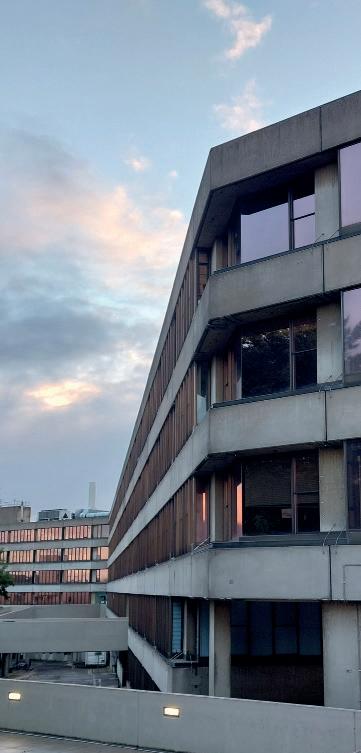
to think about wouldn’t you say?
Let’s look at one of the most notable areas we are known for, our robust climate research unit. Founded
by Professor Hubert Lamb in 1972, numerous climatologists would agree that our initial research played a major role in building the foundation of climate change understanding and allowing further investigation to ensue globally to where we are now in our vast understanding of climate change.
Not only is our climate research world-leading, but our campus-wide e orts in being environmentally conscious are consistent, with this year seeing us gain another Green Flag award (our 7th!) and climb to one of the top 40 most sustainable universities in the world.
Climate research isn’t our only
sector making headlines, it’s impossible to brush over the exciting research from all our sciences. Groups such as Dr. Darrell Green‘s being commended for their novel discovery of a therapy that increases the survival rates of those with bone cancer, the 3rd most common solid childhood cancer, Professor Sheng Qi’s leading research in developing technology removing 98% of the water from beauty and skincare products, transforming them into paper-like discs, Professor Vassilios Vassiliou’s group who have designed an easyto-use tool to identify patients at a higher risk for developing irregular heartbeats, increasing the likelihood of life-threatening diseases such as strokes, and Dr. Wenjia Wang’s work with GeoAcoustics Ltd in developing an AI (Artificial Intelligence) to perform real-time seabed mapping. These are, of course, but a few of our impressive research outputs, with our e orts spanning across targeting cancer chemoresistance, investigating stem cells, unravelling the genetics behind prostate cancer, observational astrophysics, and countless others!
We’ve strolled through some of our golden years, and we should be exceptionally proud of what we have achieved. The outstanding research carried out between the sciences and all the other
disciplines leaves much to be excited for in our future endeavours. UEA is the home of the wonderful, brilliant, and exceptionally bright. We must ensure we stay full of wonder, here’s to 60 more years of success.
This Month in Science: Blood Brothers
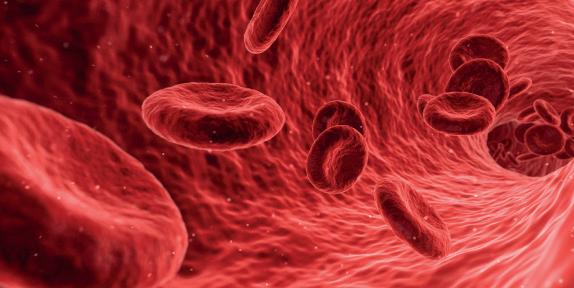 Max Todd Senior Science Writer
Max Todd Senior Science Writer
Today, blood transfusions are just one of the lifesaving tools in a medic’s armoury. From motor accidents to genetic disorders, blood transfusions are almost always essential in treating and managing conditions such as massive blood loss, anaemic conditions and poor blood quality.
But how did we get to know this ?
And who was the first to be treated ?
In September 1818, James Blundell successfully transfused blood into a man named Brazier suffering from a stomach ulcer, using the blood of several gentlemen on hand. Blundell had been researching blood transfusions for several years, building on a long history of research.
In 1628 William Harvey published
his research that proved blood was not consumed and expelled by the body but circulated indefinitely. He identified that treatment meant for curing pathologies of the blood should not be built on removing ‘diseased blood’ by means such as leeches, but affecting the circulation of the vital substance and its interactions with major organs. In
of patients being injected with blood from calf’s and sheep with limited success. Some patients survived the operation, others resulted in the physician being tried for manslaughter. This led to a century long gap in transfusion research. But Blundell believed in its capacity. Grimly, he began his research on dogs! Systematically, he drew blood out of the dogs until apparent death, before reinjecting it and watching the poor mammal spring back to life.
He proved that there was no difference in arterial or venous blood, but the species had to be the same. Advocating that “in … transfusion on the human body, human blood alone should be employed.”



recipient was that of a man named Brazier, steadily losing blood from a stomach ulcer. Though he initially recovered and was able to eat and drink, he steadily declined and died from his condition.
It took until the horrors of World War One, and the discovery of blood types by Nobel Prize winner
raise the survival rates
the decades following, the first vital experiments were carried out.
But a question remainedwhat type of blood to use ?
There are repeated instances
His treatment was also pertained to those specifically suffering from blood loss, mainly women haemorrhaging in childbirth. These women could be saved by means of safe injection. But the first
19th September 2023 16
“Nobel Prize winners, top-cited global researchers and cu ing-edge synergistic research”
SCIENCE
“From motor accidents to genetic disorders”
“One of the top 40 most sustainable universities in the world.”
Photo: Pixabay
Photo: Wikimedia Commons
Photo: Concrete/Ma hew Stothard
Karl Landsteiner, to see the mass acceptance of the power of blood transfusions in conditions of dangerous blood loss that drastically
of accidents and childbirth.
Climate Corner: Tackling air pollution with London’s expanded ULEZ
 Becky Sainty Science Writer
Becky Sainty Science Writer
As air pollution worsens around the world, London has expanded its Ultra Low Emission Zone (ULEZ). First implemented in 2019 and then expanded in 2021, from 29th August 2023 the area now covers all London boroughs. This new restriction aims to reduce air pollution in London, which although linked to climate change is mostly concerning due to its health effects. In the UK, air pollution contributes to an estimated 40,000 deaths a year. A landmark case in 2020 was of a nine-year-old girl, this was the first ruled to be due to London’s air pollution, in which her severe asthma was exacerbated. It has long been accepted that inhaling pollutants can cause

and worsen lung conditions like asthma. However, its effects spread further, increasing risks of strokes, heart attacks and cancers. It can even affect the brain, from causing developmental delays in children
London ULEZ has been resisted by many. As owners of an estimated 70,000 cars registered in the area and many who commute into it will need to pay the daily charge or replace their vehicles. However, the mayor of London, Sadiq Khan, and many supporters, insist that everyone has a right to clean air and measures like this are essential to achieve it.
by 19%, compared to estimated levels if the zone had not been established. And the reduction in air pollution levels expands past the zone itself, a trend seen in many similar schemes across Europe. Still, it is important to note that even the lowest measurements of NOx in London are double the World Health Organisation recommended limits (though in line with the higher UK limits).
to dementia in older people. Worryingly, in the light of climate change, air pollution has also been linked to a greater rise in mortality from extreme heat. The decision to expand the

Predicting the effects of these changes is hard, however many examples exhibit that the health of local populations is improved by reductions in air pollution, for example, through less traffic across or shutdown of local factories. A recent report by City Hall investigated the effects of the previous 2021 ULEZ expansion. The emission levels of nitrogen oxides within the ULEZ have reduced by 23%, and the levels of particulate matter with diameter below 2.5 μm
Hopefully, this expansion in London will be accompanied by increasing measures to tackle air pollution across the UK, in an effect to counter the wide-ranging effects it is having on our health.
Putting the pieces together
It is surprisingly easy to find out what was in a shredded document – even if the pieces can’t be put back together.

“Mum, what do we say about the chimney sheep if I only want to burn a single sheet of A4?” I ask.
“You need to take it out, but the one in the li le si ing room doesn’t have a chimney sheep in,” she says before adding, having already anticipated what I want it for, “but we have a nice shredder.”

“I don’t trust the shredder,” I say. I doubt any ill will come to me. How I destroy the address sheet of my deposit book – be it shredding, composting, recycling, just leaving it on my desk until I move house. However, when something says it’s to be destroyed, I like to do it properly. And hey, a li le pyromania is good for the soul. But did I have good reason to distrust the shredder? My first concern was a hidden scanner making a digital copy of my documents before they were shredded, as I recall one recently being used in a case by the FBI while they were investigating fraud. The art of ge ing around a shredder is nothing new. According to the New York Times, after the US embassy in Tehran was taken over in 1979, documents were given to weavers who sewed them back together. In 1995, the
German government established a team to reconstruct documents shredded or torn up by the Stasi. That said, I can already hear my parents repeating their reassurance that, “Our shredder does cross cu ing.” Had I known what I do now, I would have replied, “Oh sweet summer, child, you think cross cu ing will save you?” Even in a 2003 Times article, the company Church Street was quoted on their plans to introduce a service to reassemble crosscut paper fragments at $8,000 to $10,000 a cubic foot. $8,000 to $10,000 a cubic foot.
to move and rotate paper fragments on a computer screen, avoiding any wasted time manually manipulating tiny physical paper scraps. Exactly what tool the FBI might use is unknown. In a discussion in 2013, an FBI agent stated it took them one hour to reassemble a ribbon shredded page and eight hours to reassemble a crosscut page.
AI can also help. In 2011, a team of enthusiasts used computer code to reassemble 5 documents, totalling 7 pages cut into over 10,000 pieces to win the shredder challenge set by DARPA – the agency of the DoD (US Department of Defense) responsible for research. This averaged at least 1,400 pieces per page, more than three times the 464 pieces Consumer Reports found in 2014 that their crosscut shredder had turned their example IRS form into; though fewer than the 2,000+ that the micro-cut shredders recommended by the FBI agent produce.
my Google-foo check and missed it; or I will be woken up tomorrow by the FBI kicking down my door and demanding to know where I got the secret information from. Blame the
Whilst I doubt it would be worthwhile to reconstruct my address slip, these reassembly prices have no doubt fallen in the last twenty years. By 2009, Slate deemed cross cu ing shredders merely “more secure”. The Department of Defence required paper to be pulverized into pieces less than five mm squared or over or under onetwentieth of the squared centimetre. That Slate article also mentions a new piece of software on the block: Unshredder. This is a cheaper, semiautomatic option, costing $150 (£120.20) a year and allowing the user
So, what of these? What of these micro cut shredders or pulverisers?
Shredders are often described by their P-levels, and a P-6 or P-7 produces a result similar to dust, which shredding companies often market as being resistant to reconstruction e orts. Even the DoD is happy with a P-7.
Remember that story from the beginning. About the li le shredder that could scan. I haven’t been able to find any online references to that, which means either: I imagined it perhaps egged on by the stories that I’m about to recount; I failed
Security and Intelligence Society. However, I did manage to find at least two examples of this being done for industrial espionage. It doesn’t ma er how many pieces your shredder cuts your document
into, if it scans them first. I’ll keep burning mine, thanks. “You’re paranoid,” my father says as I strike the match. He has a point. The idea someone has snuck in to fit a scanner to our shredder is a li le absurd. I reply, “The paranoid survive.”
17 19th September 2023 concrete-online.co.uk/category/science/ | @ConcreteUEA
“Air pollution contributes to an estimated 40,000 deaths a year”
“Exactly what tool the FBI might use is unknown.”
“The art of ge ing around a shredder is nothing new”
Photo: Pixabay
Zak Steventon-Barnes Science Writer
Photo: Wikimedia Commons
LIFESTYLE
Forming healthy relationships with movement
Eve A wood
Co-Editor In Chief
What do you think about when you look back on being thirteen? Embarrassing haircuts? The emo phase you grew out of or continued for the unforeseen future? Or, perhaps a humiliating crush? In my case, it’s the anxiety I had around wanting to lose weight, and wanting to lose it fast. To have the perfect body, instead of one with stretch marks from going through puberty or bloating from periods and having endometriosis. I thought if I worked out hard enough in my room everyday I could one day look like someone else, someone pre y.
When girls are encouraged to exercise, we’re encouraged to lose weight and become thinner. It’s no wonder that by the time many girls get to secondary school, they lose interest in team sports or fitness, often out of anxiety surrounding body image issues. From a young age, we are encouraged to see exercise as punishment for eating cakes and biscuits, instead of a tool to aid our mental health and overall wellbeing. Unlike men, who are encouraged to become strong through strength-training, women are often looked down on for being ‘too manly’ or becoming
‘bulky’ if they begin weightlifting.


You may think I’m exaggerating, but I myself was in this camp. When I started exercising around thirteenfourteen doing home workout videos in my room, I often looked for exercises which claimed they would give me abs or slim down my legs. The idea of doing exercises to strengthen my shoulders or gain muscle in my legs would have scared me into thinking I would somehow gain weight or look
your body in a ma er of weeks. It is simply impossible, and anyone who tells you that you can gain abs or an hourglass figure in two weeks is lying to you. Young girls are being force-fed this kind of content across YouTube, Instagram and TikTok on a daily basis, repeatedly sold lies about magic exercises which will eradicate their stretch marks and cellulite whilst giving them a flat stomach. Like many women globally, I am in the middle of being diagnosed with endometriosis – a chronic illness whereby I experience regular
pelvic pain and menstrual-related flare ups. I have always found it hard to know which forms of exercise will be safe for me to practise. It has taken me years to experiment and to discover that yoga and weightlifting are the safest and most e ective forms of exercise for me. Weightlifting, or strength-training in particular, is something I would encourage all women to try out. It is empowering to be able to walk into a gym or practise weightlifting at home, and to see your strength increase week by week.
As women, we often feel we are intruding in a male space by even entering the gym, and because of our menstrual cycles, we have to approach exercise in a di erent way. I want to see more women and young girls educated about how movement can be something enjoyable instead of something forced. Exercise should be a way for women to improve their wellbeing and strength, not just to fit into size zero jeans.

too masculine. I was uneducated about strength training and the amazing e ects it can have for women, and so I stuck to exercises which were ultimately ine ective and promoted unhealthy habits.
With the resurgence of pilates on apps such as TikTok, many have flocked to exercise classes in the belief that doing an hour of pilates each week will give them J-Lo’s body. I hate to break it to you, but that’s not the case. There is no miracle exercise or class that will transform
Why does moving back home between semesters feel so stifling?
Vu
I board my flight from London Heathrow to Los Angeles International Airport every semester, ecstatic to see my friends and family after long, cold harsh months slaving away at the library and ro ing in my bed, yearning to see the sun and smile with my eyes closed.

Except I come back to the reality that my family dynamic has too much turbulence that was forecasted, but I chose to ignore it. And everyone moves on, some of my friends becoming semi-unrecognisable. Then I remember exactly why I had left, and I should listen to the weather forecast from then on. Things have changed so drastically in the short amount of time I’ve been gone, forcing me to question where my home really is. The truth is: I’ll never be that 18-yearold girl who was naive, yet optimistic
about moving overseas again, yet I always try to revert back into her.
Constantly having to walk on eggshells in order to not ignite
and essentially made it ours, so now I don’t have the same selfexpression as I did when it was just me, the sole habitant of that room. My pent up anxiety from having the freedom to just get up and go stripped away from me continues to bubble, with each scream full of anguish begging to be let out. But, I can’t. I have to go through my breakdowns alone. Just me, in my enclosed space, trying to regulate my heavy, shaky breaths through my never ending tears, su ocating.
scrolling on my phone mindlessly, thinking about the ‘what-ifs’ in life. What if I had decided to stay at home for university? Would I still feel this numb, empty, confined to this horrible routine?
Being strictly confined to a car made life more di cult. Being at university, I at least was able to take the (overpriced) train to London for a city break, or take a short trip to the coast. I could easily do my shopping with a bus ride away, but being at home and not knowing how to drive, I was limited on where I could go. Despite re-learning how to drive and now being able to just go, there’s still this hollow feeling I get every time I pull into my driveway, knowing I’m going to be back in the outgrown box of 18-year-old me: restrained and having never ending feelings
of anguish. It feels like no ma er what, it’s never enough. The more I’m left alone, the more I ask myself if life is just monotonous repetition. Despite the turbulence, I do love being at home and catching up with my friends and family, but I also have to accept the bi ersweet fact that I can only love certain people from afar and when we get too close, that’s when there’s trouble. It’s a hard truth I have trouble accepting to this day because I value the limited time we have to spend together now. I still have trouble moving on, as my mind is still clinging onto the good memories I made when I was 18. Every time I go home, I’m still su ocating in the shadows of 18-year-old me.
an argument and not having the freedom to leave, I confine myself to my room with baby pink curtains and cow print bed sheets. My own four walls that I’m able to call my room, one of the biggest privileges I have. Except while I was gone, my sibling took over my room
I went from having the freedom to frolic around until the late hours of the night to being confined to my room, repeating the same old, same old. Eat, sleep, scroll. No hikes, no runs, no beach days. At least at university, I had the freedom to run around campus and relieve my stress. Running at night as a lone woman in my area is considered suicide. So it’s back to
19th September 2023
"I thought if I worked out hard enough in my room every day I could one day look like someone else."
18
"Would I still feel this numb, empty, confined to this horrible routine?"
Lin
Lifestyle Writer
Credit: Unsplash
Credit: Unsplash
Anne Glia
Agony Aunt
Q: I've come to UEA as an international student and I'm experiencing some culture shock, especially with adjusting to being away from friends and family. I'm worried about making friends when it seems like university life revolves around drinking and clubbing so much. What should I do?
A: There's no doubt that starting out at university as an international student is particularly di cult. Unlike UK-based students, you're not just adjusting to university life, but from being in an entirely di erent home country and culture. Please know it is completely normal to feel overwhelmed or even isolated. Reach out to other international students through joining clubs and societies, as well as events and workshops. If it all gets too much and you feel as though your mental health is really struggling, reach out to UEA's wellbeing service or even seek advice from the UEA Medical Centre.
Drinking can be a large part of the university experience for some people, but not all. There are plenty of opportunities to meet people other ways, such as through clubs and societies, or to go on day trips to places such as Norwich city centre, bowling, the cinema, or even the beach! It's your university
experience, not anyone else's, so don't let social media or unrealistic expectations dictate what you do. Make sure to also keep in contact with your friends and family from back home on a regular basis. FaceTime and video chat will be your best friend, and it's okay to admit you need some home comforts sometimes. Many UK students will go home at certain points during the term time to visit family, but
Q: I've recently seen that the UEA Pharmacy will be closing down. Where can I go if I'm a student who requires regular prescriptions? I'm worried that I won't be able to get the medication I need for my condition.


A: The first step I would take is to check which are your most local pharmacies. Check on Google Maps which pharmacies are closest to the accomodation you're in for this year and how long the walk/bus ride would be. There are several pharmacies near the university which are walking distance, such as Allied Pharmacy, West Earlham. However if you're a first year, you may find it easier going with one in the city unless there's one on your door step, as it you're still ge ing to know the area.
a lot of international students don't have their priviledge, having to stay over holidays for financial reasons. It's even more important during these periods to make sure you interact with other students experiencing the same situation, as this will be a comforting reassurance that you're not alone. Events and workshops particularly intended for international students are often promoted on the SU Instagram, as well as on the SU website on 'Events'.
If you're going to a pharmacy in the city, you can catch the 25/26 bus from the university bus stop. There are several pharmacies in the city, including in the major shopping centres and along the highstreet.
The SU has made a post on their Instagram detailing loads of pharmacies you can access in Norwich. Some of these also close later in the evening, such as Boots Castle Mall (Mon-Wed and Fri-Sat 8am-9pm, Thu 8am9pm, Sun 10:30am-4.30pm).
The reclamation of girlhood through ‘girl dinner’
Mia Galanti Lifestyle Editor
If you have been on social media in the past month, you will have undoubtedly encountered the viral TikTok-borne trend of ‘girl dinner’. ‘Girl dinner’ began specifically as a quipped response from to a TikTok video about how the ideal meal is the imagined one of a medieval peasant, specifically one with emphasis on breads, cheeses and fruits. Thus, for a while after, girl dinner became emblematic of what most closely resembles a charcuterie or apero hour: collections of snack-like foods such as olives, crisps, cheeses, pâté, bread and sliced meats. In essence, not a full meal as we have traditionally come to define it of two or more large elements, but rather a collection of small snack-like elements. But then the girl dinner trend started taking on a life of its own.
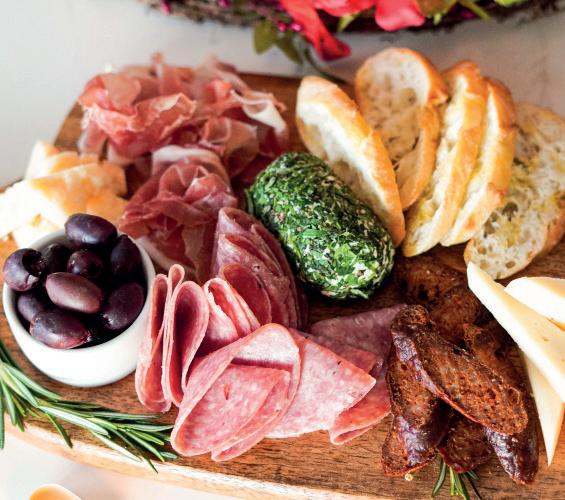
Instead of an assortment of breads and cheeses, girl dinner became representative of anything. The trend did not discriminate: over the viral growling, harmonic soundbite of a woman trilling “this is my meal, I call this girl dinner”, women showcased their own unconventional dinners, from instant ramen to tubs of ice cream to simple grilled cheese sandwiches. The trend even took on
Alternatively, there are online services you can use to access your prescriptions, such as Pharmacy2U, NHS Find a Pharmacy, and Allied Pharmacies iPharm. Make sure if you're a first year student or international student that you also register with the UEA Medical Centre for when you need to book an appointment with the GP. You may be asked to do this before your prescription can be sent to the pharmacy, so don't leave it until the last minute!
a more humorous, abstract sense, with some Internet users displaying favourite books or squishy Barbie shoes as their ‘girl dinner’. What is so joyful about girl dinner is, at the heart of the trend, its
celebration of female joy. On the surface, girl dinner is merely a funny trend about women eating cake for dinner. However, its importance cannot be understated. Women and food and their subsequent relationships with one another have been long since demonised. Food has been made inextricable from what a woman’s body looks like, and therefore for years women have forced themselves on restrictive diets to fit what is seen as societally ‘acceptable’.
In this way, girl dinner is almost subversive. There is a reclamation of food, with a lot of the ‘girl dinner’ meals being food traditionally deemed childish or unhealthy or shortcuts, such as cake or bread or frozen meals. The ideal of a perfect domestic housewife involves skill at cooking, both at assembling and plating, so the simplistic, snack-like dinners feel like a direct challenge to the stereotype, showcasing women who cannot cook or prefer simpler meals, unconcerned with whether it looks nice but above all prizing
their own comfort and delight in eating. In a society that still prizes a slim body forged through restrictive dieting and excessive exercising, the joyful showcasing of pasta and oven pizza and microwaveable egg rolls is a quiet, peaceful protest.
For many women, childhood and growing up a woman has long been characterised by being told what and what not to eat, oftentimes to appease outside opinions on their growing bodies. Therefore, girl
dinner is not only subversive but a reclamation of girlhood. The fact the trend is nicknamed ‘girl’ dinner as opposed to ‘woman’ dinner, even though most participants are moving-out age, further highlights this. It is about re-embracing the childlike delight in food, through eating cake or messilyassembled snack plates for dinner. It is for this reason that 'girl dinner' is one of my favourite social media trends in recent memory.
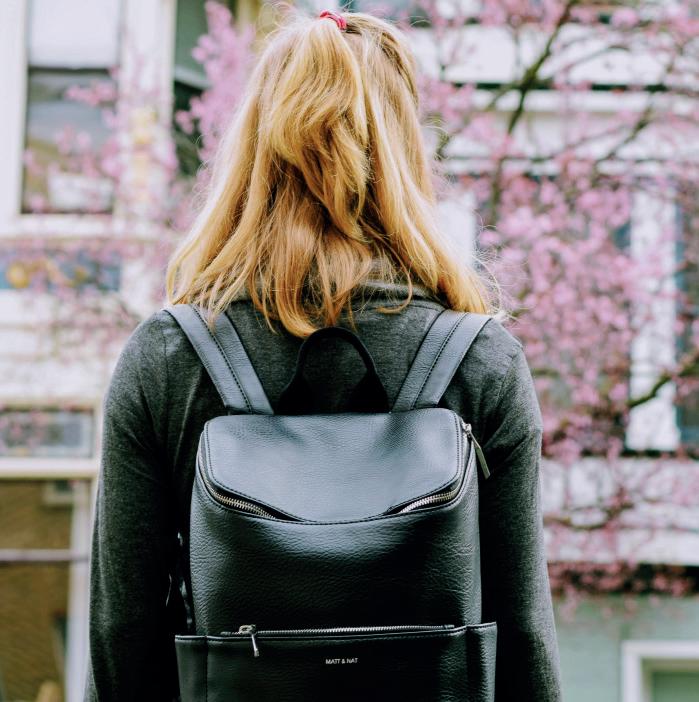
19
19th September 2023
Your
concrete-online.co.uk/category/lifestyle/ | @ConcreteUEA
"What is so joyful about girl dinner is [...] its celebration of female joy."
Credit: Unsplash
"It's your university experience, not anyone else's."
Photo: Unsplash
The Journey Back to University
Cordelia Gulbekian Travel Editor
On the journey back to Norwich after many months travelling in Australasia, I found myself asking the question: am I ready to start university again? The answer seemed like a jumble of words in my head: yes, I’m excited to move back and be around my friends, and no, the routine of studying, the late nights, the piling deadlines and badgering anxiety of more reading, more writing, more early classes. No, I’m not ready for that. And after so long study-free, in a haven of summer activities and adventures, will my brain even be able to function in a routine and organised way? The thoughts gathered in an anxious cloud inside my head. And what about the other part of living as a student, renting your own house, looming bills and broken taps, chasing your landlord for a working door. No, no, I’m not ready for any of that.
It felt almost as if my mind had switched part of itself down, the side that deals with these anxieties and faces them head on. The other side is still lit up, planning adventures with friends and deciding on ways to spend free time. For the last couple of months, I’m lucky enough to have
spent my weeks travelling, relaxing, and working, a sanctuary from studies. In the back of my head there haven’t been any impending deadlines which I’ve procrastinated to the last possible minute before I’m forced to hand something in. And yet, it’s not dread I feel, but a fear that the switch between these two mindsets might feel like being dropped in boiling water, metaphorically of course.
I know I’m not the only one experiencing this mental battle, these billowing anxieties, on their way back to university. However,



there’s a feeling of excitement. I’ve experienced this before, this mix of emotions. It’s a natural part of returning to university and an independent lifestyle; exciting, scary, and a shift in mindset.
Anxiety is a natural part of doing anything; you question your abilities despite the knowledge that you can and will do it. I’ve spent half a year studying abroad on the other side of the world, New Zealand, the island at the furthest point from the United Kingdom. My summertime has been a fraction of what I’m used to; when I returned home in late July, I came from winter, experiencing August as the shortest summer of my life. During my travels, I planned complicated routes, took countless buses
and trains in another country, turned up in a classroom filled with new faces and new ways
of teaching and lived in a house filled with strangers who became like a family away from home.
Unlike New Zealand, returning to Norwich is familiar to me. University life promises exciting opportunities, leading you out of your comfort zone. It offers constant challenges which you face and realise that you are perfectly capable to confront. These thoughts push me forward towards the new term.
From Geysers to green energy: Sustainability in Iceland – Aurora Alliance Trip to Reykjavik
Aurora Alliance Group
UEA, in collaboration with the University of Iceland and the Aurora Alliance, sent five students to Iceland for a week in September. The purpose of the trip was to explore sustainability and how Iceland went from a pre-industrial society to a world leading fully renewable nation, and to investigate what lessons could be transferred to the UK.
The idea of sustainability permeates every facet of Icelandic society – ranging from the smallest things, such as the abundancy of places to fill up your water bottle for free and the widespread derision of people who drink from plastic bottles, to the geothermal plants and hydroelectric power stations scattered around Iceland.

Alongside the stunning waterfalls, natural springs, geysers, and volcanoes of the natural landscape, you will also find construction projects of considerable scale – such as the Hellisheiði Power Station. The largest geothermal power station in Iceland, situated
in the southwest, is a striking view even from a distance with its billowing clouds of steam rising from massive turbines. Vista aside, it is a marked example of Iceland’s dedication to sustainability. The energy is harvested at the power station, before being spread throughout the nation, particularly in urban hubs such as Reykjavík to heat houses, melt snow on driveways and paths and car parks, assist in fish farming, and other industrial usages such as greenhouses. They
streets, removing ice and snow.
The idea of zero waste is pervasive – for example, at a breakfast bar you may find jam, butter, sugar and salt all in a dispenser, rather than in small packets. Rather odd for a British palate, accustomed to single use containers, but very normal to an Icelander.
operate on a philosophy of near zero waste, so the same heated water that goes into houses is recycled as it cools off, going into cheaper plastic tubes at a lower temperature to heat the
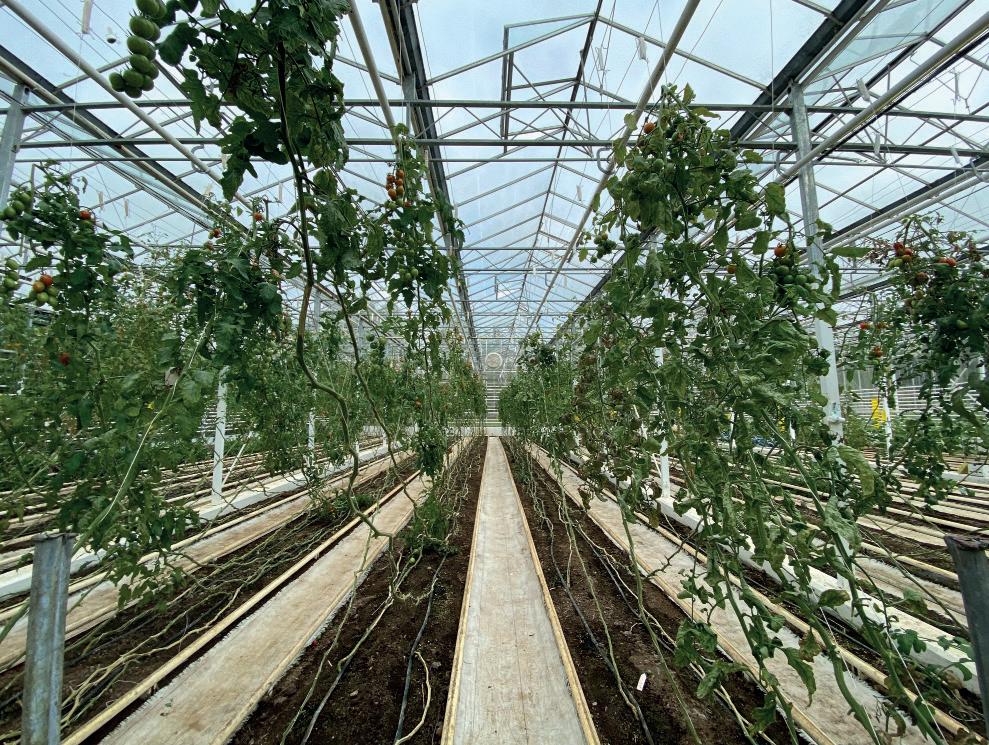
Today, Iceland is at the forefront of the green revolution, but it wasn’t always like that. Prior to the oil crisis of the 1970s, Iceland was more akin to a ‘normal’ industrial nation, reliant on imported oil (from the USSR) to heat its homes and power their stoves. The government at the time decided to subsidise the price of oil, but they, and the Icelandic people in general, were determined to be self-reliant, and reliant on clean, domestic energy. This sparked a wave of investment into geothermal and hydro energy with massive payoffs; by 1980, just a short seven years after the oil crisis began, the nation’s heating was almost entirely decarbonised.
Today, Iceland has continued this road, with investments into emerging green technologies such as carbon fixation, as well as exporting their knowledge to
nations around the world – the United Kingdom being one of them.
Iceland’s story is an impressive and awe inspiring one. It shows that it is possible to transform a nation’s energy, though the journey might have its ups and downs, no matter what the naysayers say. There are many comparisons to be made to the UK as well – both island nations in the North Atlantic, with vast coastlines, diverse terrains, and a rich history of adapting to
change. Both countries share a spirit of resilience and the capacity for innovation, yet Iceland has demonstrated a rapid and effective transition that the UK could learn from. With the UK rejoining the European Horizon programme, a move heralded as good news by virtually all British Universities, the spirit of collaboration and learning has been rekindled. Iceland has proven it’s possible and it's time for the UK to step forward and become a leader in the green revolution.
20
19th September 2023
"Am I ready to start university again?"
TRaVel concrete-online.co.uk/category/travel/ | @ConcreteUEA
"Returning to Norwich is familiar to me"
Photo: Hanee Bente Rasdeen
"Today, Iceland is at the forefront of the green revolution"
Photo: Trixie De Guzman
Puzzles & Games
Crossword

Word Search



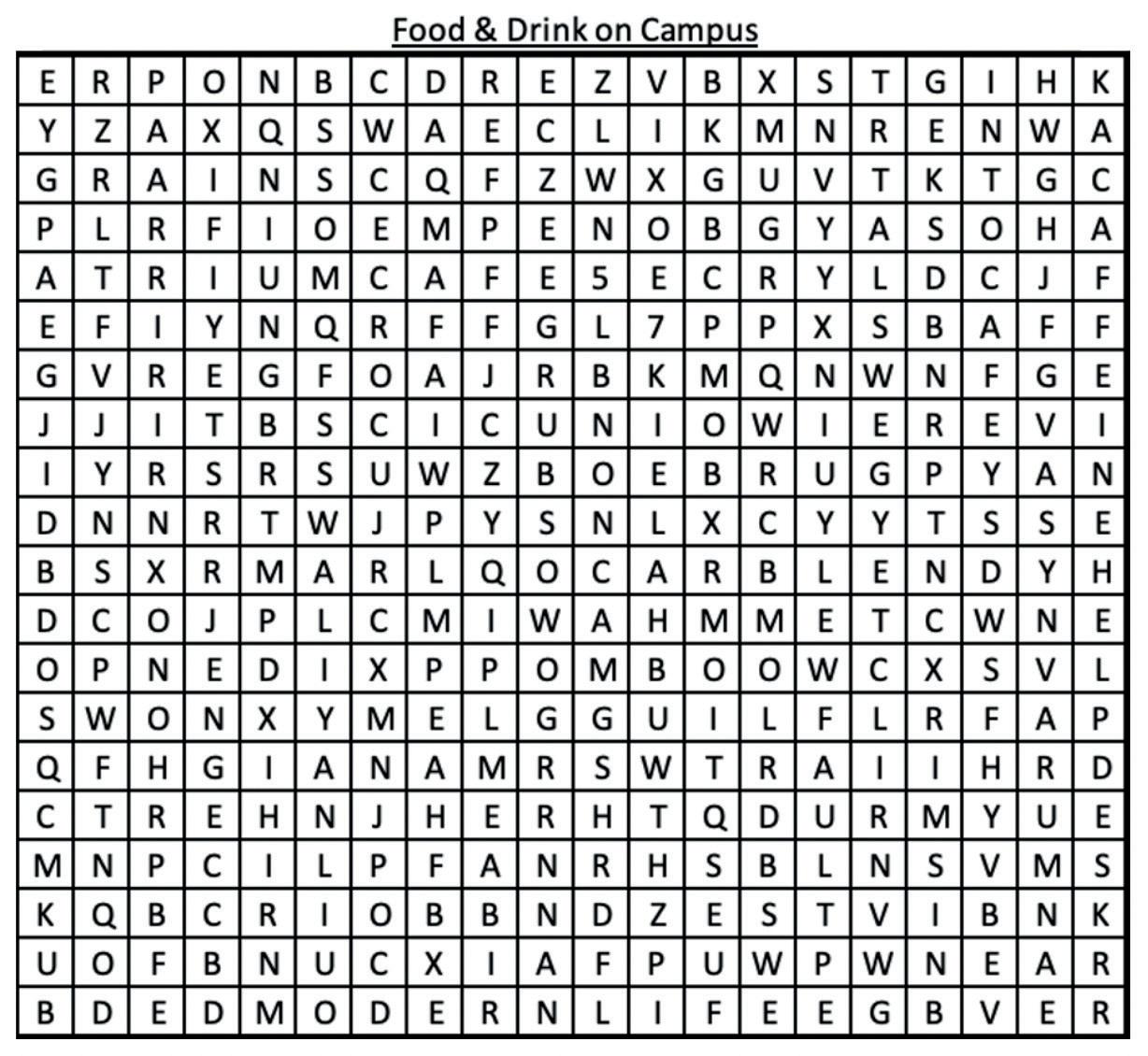
19th September 2023 21 @ConcreteUEA
AnswersonPage2
Photo: Concrete/Prakrita Rahman
Sport
“I cannot continue my work”- Luis Rubiales resigns as President of RFEF
Sofia Royal Sports Editor
It was a match set to grip the nations of the world when England and Spain went head to head in this year’s Women’s World Cup Final. Whilst England had a clean sweep through to the finals, it was the women’s Spanish team that conquered the trophy, leaving England, once again, empty handed. What was meant to have been a victorious moment for the 23 members of the Spanish team, soon became tainted during the medal ceremony, when President of the Royal Spanish Football Federation (RFEF), Luis Rubiales kissed Spanish midfielder, Jenni Hermoso on the lips. In a matter of hours, Rubiales’ actions created shock worldwide, and Hermoso took to social media to confirm how she “felt vulnerable and a victim of an impulsedrive, sexist, out of place act without any consent on my part.”
Since the incident, Rubiales was faced with a 90 day suspension, banning him from all football activity. In his replacement, Pedro Rocha was keen to distance Rubiales from the RFEF, stating in a letter: “The damage caused to Spanish football, to Spanish sport, to Spanish society and the values of football and sport as a whole have been enormous.”
“We feel especially sorry and ashamed for the pain and additional distress this has caused.”
In an interview with Piers Morgan, Rubiales announced “I cannot continue my work”, confirming his
resignation as President of the RFEF and Vice-President of UEFA’s executive committee. During the interview, Rubiales implied that the impact of public opinion on family, particularly his daughters, was a fundamental cause towards his resignation. In a statement that followed, Rubiales affirmed: “After the quick suspension carried out by FIFA, plus the rest of the opening proceedings against me, it is evident that I will not be able to return to my position.”
“Insisting on waiting and holding on is not going to contribute to anything positive, neither to the federation nor to Spanish football.”

Rubiales’ resignation comes after Jorge Vilda, the Spanish coach which led the Women’s team to victory had been sacked after eight years. Vilda, who initially supported Rubiales after the final, said “I did not deserve my sacking… what hurts most is that my honour and behaviour are questioned.” The RFEF gave no specific reason as to why Vilda was fired, but described the move as one fo the first “renewal measures”, since the final. As a result, Vilda has been replaced by his former coaching assistant, Montse Tome.


Saint George
Matt Newson Sports Writer
England launched their World Cup against Argentina with expectations at an all-time low, following a dismal run of five defeats in six tests. However, George Ford catapulted England off to the perfect start against Argentina, scoring all 27 points as they ran out 27-10 winners in their opening World Cup match. With a controversial first half red card offence committed by Tom Curry, England were down to fourteen men for 77 minutes, however, the experienced fly-half ran the game to perfection, co-ordinating the attack contributing three beautiful drop kick goals to bolster the score line. In defence, another sensational game from Ben Earl and co, including England’s captain, Courtney Lawes and super sub

teammate, Lewis Ludlam allowed the defence to secure the win, whilst Owen Farrell watched from the stands in Marseille. What does Steve Borthwick do with his captain once he’s free from suspension?
Ford appears to be liberated when he is running the show out there, he seems a different player when he’s not under Farrell’s shadow. So many times in the recent past, England have lacked control, but Ford delivered it in the most stunning way. With the following group stages to come, changes are expected to join this fresh England side, but how far it could take them, nobody seems to know. And if it will be Ford or Farrell who leads the team at ten – I know who I’d prefer it to be!
Although, Rubiales has made the first correct decision since the World Cup Final, it is only the beginning for this case. Jenni Hermoso, has since filed a legal complaint based on Rubiales’ actions that, if found guilty, he could spent up to four years in prison. A Spanish high court judge has now opened an investigation, which will decide whether the case goes to court or if it will be dismissed.
F1 RECAP: Verstappen’s Dutch delight as he takes pole at Zandvoort and Monza
saw both Ferrari’s in the top three for a fundamental home race, it was championship leader, Verstappen
The following weekend, the driver’s took to the final race of the European leg of the season at Monza. After a tense qualifying that
who was their biggest threat. Alpha Tauri were not too fortunate once again this weekend, after Yuki Tsunoda suffered from engine failure during the formation lap, resulting in a later start for the race. It was just the weekend before that Alpha Tauri had to make a change of driver for the second time this season, when Daniel Ricciardo broke his hand in a collision with Oscar Piastri during free practice, resulting in reserve driver, Liam Lawson taking over for the foreseeable future. In an interview at Monza, RedBull team principal, Christian Horner stated: “I don’t think [Daniel] will be ready for [Singapore]”, adding that it would be “optimistic” to see Ricciardo return for the Japan Grand Prix.
One driver has ever achieved. As the drivers take to the street circuits of Singapore, it is a wonder if Verstappen’s streak can be stopped or if he will make it to 18 consecutive wins by the end of the season. After this years mid-season summer break, it appeared the all twenty drivers were well-rested and ready to swap their luxurious yachts in the Mediterranean for a 230mph car in Zandvoort- home to not only the Dutch Grand Prix, but also two-time WDC winner, Max Verstappen. With the added pressure of thousands of eagle-eyed Dutch fans raring to watch Verstappen take the reins to victory, it was perhaps that this race win would create history, that lied more heavily on the driver’s shoulders. 9 consecutive race wins, was the record that former RedBull driver, Sebastian Vettel held. However, not even heavy rains could stop Verstappen as he led the way, overtaking his previous teammate and Alpine driver, Pierre Gasly, whilst also passing current teammate, Sergio Perez. It was however, bad luck for rookie, Logan Sargeant who lost control of the Williams at the exit of Turn 8, crashing into the barriers. A full Safety Car followed suit, which later saw Ferrari driver, Charles Leclerc retire due to floor damage caused by debris from Sargeant’s car. A third DNF was then called, when heavy rains got the better of Zhou Guanyu, allowing for the RedBull’s to pit for full wet tyres. Whilst it seemed that Perez would have an advantage, he was unable to catch up to Aston Martin’s, Fernando Alonso, who took second place, and Pierre Gasly, who scored a surprising fourth podium for Alpine this season.
The Italian Grand Prix saw multiple close battles. One in particular, was from the two Ferrari’s of Sainz and Leclerc, who, behind both RedBull’s, were battling for third place within the last three laps. Coming into Turn 1, the Ferrari’s had a few near misses with Leclerc locking-up on his brakes. However, Sainz fought-off his teammate, maintaining his podium position, behind Sergio Perez and Max Verstappen, crowning him with a record-breaking ten consecutive race wins, the most a Formula
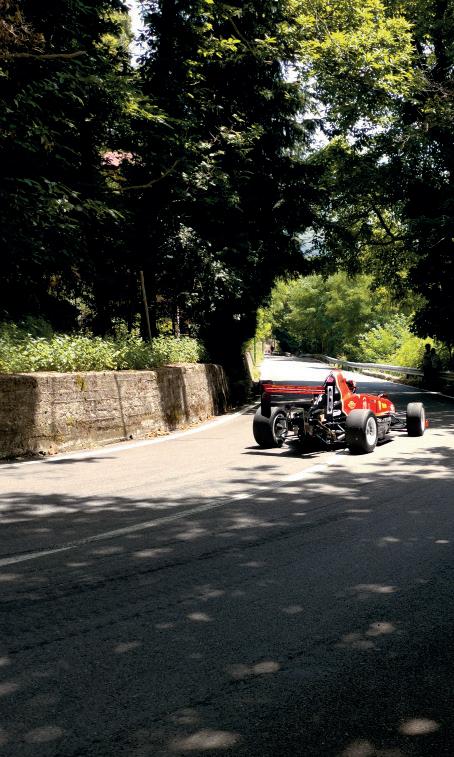
19th September 2023 22
"A record-breaking ten consecutive wins, the most a Formula One driver has ever achieved."
"Insisting on waiting and holding on is not going to contribute to anything positive"
Sofia Royal Sports Editor
Credit: Unsplash
Credit: Unsplash
Not quite a spa day
Matt Newson Sports Writer
Being a motorsport fan we can become self-indulged in the excitement that follows when a safety-car comes out and the entertainment that we, as viewers, receive when the grid has been switched up; but at what point do we say enough is enough? At which point do the injuries and fatalities to our idols makes us question the so-called entertainment?
Since the tragic passing of Jules Bianchi at the 2014 Japanese GP, safety regulations across international racing tracks, marshals, and the cars driven in all categories of motorsport, have been closely scrutinised by the FIA and
other governing bodies resulting in major reform and changes to safety. One track in particular, ‘Le Circuit de Spa-Francorchamps’ has come under major scrutiny after two deaths in separate incidents have occurred in recent years.
Arguably, the most famous corner in all of motorsport ‘Eau Rouge Raidillon complex’, is a blind summit peak on the circuit, responsible for the two crashes and fatalities due to barrier placement and the nature of the ever-narrowing corner that leads back into the racing line. Eau Rouge-Raidillon is not, crucially, getting changed. The runoff around it is getting adapted so that if you
US Open: Grand slam success for Djokovic and Gauff
Sofia Royal Sports Editor
In what has been another tumultuous US Open, Novak Djokovic went to head to head with Daniil Medvedev in this years final. Showing off to a star studded audience in New York, Djokovic took the opening set 3-6. It was however within the second set that Medvedev proved a challenge with the set lasting one hour and 44 minutes, before Djokovic took the set 6-7. The pair exchanged breaks early on in the third set, as Djokovic’s win was sealed when Medvedev hit a forehand into the net, claiming his fourth US Open victory for the first time since 2018. On winning his 24th grand slam title he stated: “It obviously means the world to me.” “I’m really living my childhood dream to compete at the highest level in this sport, which has given me and my family so much from difficult circumstances.”
To 19 year-old, Coco Gauff, achieving her first grand slam title means so much more. After suffering a gruelling match with Laura Seigemund, who persistently prolonged her preparations prior to receiving Gauff’s serve. Gauff spoke
up to the umpire, arguing “I don’t care what she’s doing on her serve but on my serve she has to be ready”. Dominating in her matches, Gauff made her way to the final against Aryna Sabalenka. In the opening set, Gauff began nervously, with both players making errors, for Sabalenka to take the set 2-6.
Following by the growing support of the crowd, Gauff, bounced back into the second set, withstanding rallies with Sabalenka, to take the set 6-3. Into the third set, the players competed in a 40-hit rally, but it was Gauff, who took the advantage and gained a 6-2 victory. In her post-match interview, Gauff said: “It means so much to me, I feel like I’m a little bit in shock”, before expressing her gratitude towards her parents and “team”.
crash there, your car will not be flung into the path of oncoming cars. Although race cars are designed to withstand crashes, they are not meant to be ploughed into, sent airborne, and flipped by each other. Unfortunately it’s not just circuits designs which put our beloved drivers at risk, but also the safety mechanisms put in place, with many of them now out-dated for the current crop of race cars today, or the fact that the technology just doesn’t work to prevent crashes or injuries. Two major incidents during an IMSA weekend at Virginia International Raceway raised some questions about the barriers of wrapped and
linked tires used by many road racing tracks and series, including Formula 1. Leading to people believing maybe it's about time to find a better safety alternative, than tire walls on road racing circuits. These barriers have proven effective at absorbing and spreading energy upon impact. The systems have come a long way from the days of simply stacking tires.
Despite this, it is not all negative news! At the 2020 Bahrain Grand Prix an incident involving Romain Grosjean showed just how much motorsport safety had improved. Grosjean’s car split in half and exploded into flames. While the
incident was terrifying to see, Grosjean was taken to hospital with only minor burns and broken ribs. A stark reminder of how dangerous motorsport can be, the incident was also a testament to just how hard the FIA and F1 have worked to improve safety over recent years. But with F1 setting the tone for the rest of the industry, and the resulting developments in technology feeding through ultimately to road cars, it has never been safer to be in a car than it is today.
From the desert to the pitch: How Saudi is influencing European football
 Felix Sumner Senior Sports Writer
Felix Sumner Senior Sports Writer
There is no hiding the fact that during this year’s summer transfer window, Saudi Arabia’s Pro League has been dominating in terms of moves from high profile players.
It isn’t surprising that the Saudi Pro League is up and running, finding its place amongst the great competitions of the game such as the Premier League and La Liga. The investment into the game there, is also undeniable. Through the arrival of Cristano Ronaldo, the lust for playing in the desert was born. Having one of the best in the world indulged in this underthe-radar league only propelled it forward into the spotlight, after having been claimed by Ronaldo it would be better than the European leagues in a few years to come.
This summer has seen the Saudi Pro League flex its muscles again in attracting many European stars of the game. From the likes of Neymar Jr. to Jordan Henderson,
it has brought in talents for also eye-watering fees and contracts. This is reinforced by Al-Hilals relentless pursuit of French World Cup winner and super talent, Kylian Mbappe, where they were putting values as high as £250 million on the table, but the move was never pulled off. The appeal of Saudi football is clear: Money talks.
Clearly, this has been met with controversy from both fans, players and officials. The argument for either side is just as compelling. Fans have likened it to “sports washing”. Through the appeal of money from the state government, it has attracted a cult of standout and ageing players from Europe to boost the popularity of the league. However, fans argue that this is completely wrong and obviously upwards of £170 million annually (as is the case for ex-Madrid striker Karim Benzema) and portrays the game negatively. The “sports washing” in Saudi is detrimental to the game, and especially to the
English game where historically it is known as “the working man's game”.
However, despite all this, some players were open to voice their opinions. Some have said that their moves have been down to wanting a new challenge away from Europe and claimed it is not for the money. Others have argued that the Saudi Pro League is simply pumping money into the league to raise the competitiveness and prestige of it so, it too, can be at the same towering heights of the Premier League. Some have even compared both of the leagues and explained that when clubs, such as, Newcastle United, are bought by huge government organisations, they can use huge sums of money to invest in the game.
Either way, it is clear. The Saudi Pro League is rising, and this summer transfer window will not be the last time we hear from it, but questions remain of financial fair play and even human rights in the desert.
23 concrete-online.co.uk/sport/ | @Concrete_UEA 19th September 2023
Credit: Unsplash
Where are they now?: The sports star alumni of UEA
Sofia Royal Sports Editor
This month, UEA celebrates its 60th anniversary. Whilst, UEA has garnered some recognisable faces to their alumni over the last sixty years, it must be said that a few have made a name for themselves in sport.
To rugby fans, Andy Ripley OBE attended UEA back in the sixties, where he achieved his Bachelor’s Degree. He pursued his education further at the London School of Economics and Hughes Hall, Cambridge, where he was awarded his M.Sc. and a MPhil. Although his lifelong career was as an accountant, Ripley made his international debut in 1972 in the England vs Wales match, at Twickenham. Ripley continued his rugby career beating both Australia and the All Blacks in 1973. The following year, he became a member of the unbeaten 1974 Lions, but played his final match for England in 1976. Andy Ripley sadly passed away in 2010 from prostate

cancer, however his name still lives on within UEA with the Andy Ripley Memorial PhD Studentship, funding for cancer studies.
Rower, Natasha Howard studied at UEA, where, in 2002 she achieved a Bachelor of Science. At UEA, she learned to row, creating a new-found love for the sport. In 2005, Howard became a newcomer to the team GB senior women’s squad and in 2007 won the women’s pairs event at the GB rowing senior trials. The following year, Howard went on to row for Great Britain in the 2008 Beijing Summer Olympics, famously taking part in the women’s eight.
For the world of Formula One, James Vowles studied at UEA, where in 2000 he obtained a degree in computer science. Whilst at university, Vowles sought opportunities in several Formula One teams, aiming to use his mathematical education in the racing
industry. However, he faced rejection as mathematics was not required at the time. It was suggested by the teams that Vowles should obtain an engineering degree in order to break his way into the sport. The following year, Vowles earned a Master’s in Motorsport engineering and started his career in Formula One with the British American Racing team. Over the past two decades, Vowles has stayed with the team through its transitions into Honda Racing F1, Brawn GP and more currently Mercedes. It was however, earlier this year that Vowles announced that he would leaving his role as team strategist for Mercedes and taking over as Team Principal of Williams Racing for the 2023 season.

19th September 2023 24 Sport
Credit: Unsplash
Credit: Concrete/Samuel Baxter


























































 Molly Warner News Editor
Molly Warner News Editor









 Jamie Bryson Features Writer
Jamie Bryson Features Writer









 Matthew Stothard Co-Editor-In-Chief
Matthew Stothard Co-Editor-In-Chief



















 Rana Dawood Science Editor
Rana Dawood Science Editor

 Max Todd Senior Science Writer
Max Todd Senior Science Writer


 Becky Sainty Science Writer
Becky Sainty Science Writer






















 Felix Sumner Senior Sports Writer
Felix Sumner Senior Sports Writer

